Advantech Co EKI6311G IEEE 802.11b/g Wireless Access Point/Client Bridge User Manual Quick install
Advantech Co Ltd IEEE 802.11b/g Wireless Access Point/Client Bridge Quick install
User manual
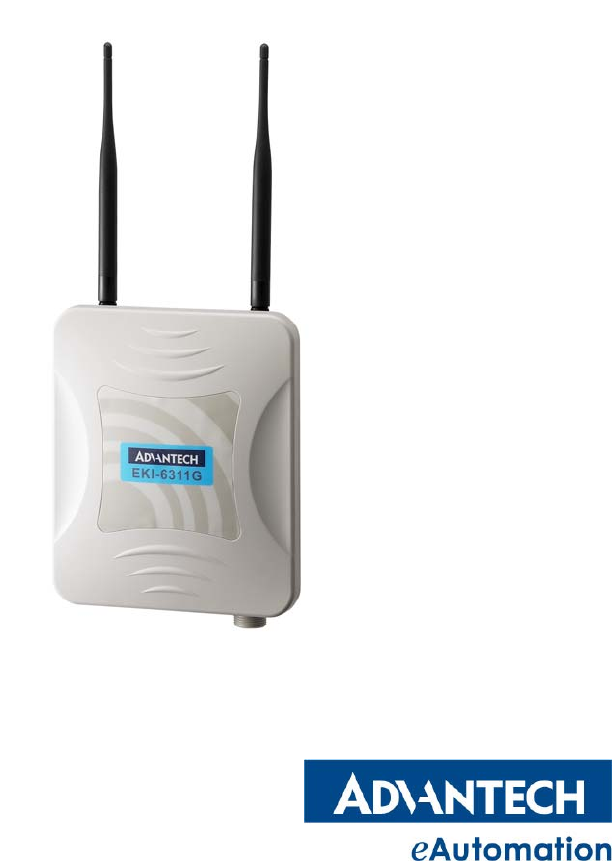
EKI-6311G
IEEE 802.11 b/g Wireless Access Point/Client
Bridge
User Manual
1

► Contents
Chapter 1. Introduction ...................................................................................4
1.1 Introducing the EKI-6311g ............................................................4
1.2 Product Features ...........................................................................4
1.3 Package Contents .........................................................................4
1.4 System Requirements...................................................................5
1.5 Inline Power Injector (PoE) ...........................................................5
Chapter 2. Installation and Basic Configuration ...........................................6
2.1 Before You Start.............................................................................6
2.2 Locate the EKI-6311g and Inline Power Injector Ports ...............7
2.3 Preparing Installation....................................................................9
2.4 Basic Configuration .................................................................... 11
2.4.1 Logging into the Web Interface........................................... 11
2.4.2 Basic Configuration Steps...................................................13
2.4.3 Set Operating Mode, IP Address, Subnet Mask, Default
Route IP, DNS Server IP of EKI-6311G..............................................14
2.4.4 Set Wireless SSID for Wireless Interface ...........................16
2.4.5 Set Wireless Encryption for Wireless Interface .................17
2.4.6 Change Supervisor Account & Password..........................18
2.4.7 pgrade the Firmware ............................................................19
Chapter 3. Network Topologies ....................................................................20
3.1 Wireless Client Bridge-to-Central Wireless Bridge ..................21
Chapter 4. All function on Device.................................................................22
4.1 SYSTEM........................................................................................22
4.1.1 Administrator........................................................................22
4.1.2 Firmware ...............................................................................23
4.1.3 Configuration Tools .............................................................24
4.1.4 Status ....................................................................................25
4.1.5 Log.........................................................................................26
4.1.6 System Time .........................................................................27
4.1.7 Reboot...................................................................................28
4.2 NETWORK....................................................................................29
4.2.1 Network .................................................................................29
4.2.2 HotSpot(Captive Portal)..................................................32
4.3 WIRELESS....................................................................................33
4.3.1 Wi-Fi 1 ...................................................................................34
4.3.2 Wi-Fi 2 ...................................................................................34
4.3.3 Wi-Fi 3 ...................................................................................34
4.3.4 Wi-Fi 4 ...................................................................................34
4.4 ACL ...............................................................................................35
4.4.1 ACL for Wi-Fi 1 .....................................................................35
4.4.2 ACL for Wi-Fi 2 .....................................................................35
4.4.3 ACL for Wi-Fi 3 .....................................................................35
4.4.4 ACL for Wi-Fi 4 .....................................................................35
4.5 SNMP ............................................................................................36
2
4.5.1 Agent Settings ......................................................................36
4.6 EXIT ..............................................................................................36
Chapter 5. Specifications ..............................................................................37
Chapter 6. Default Settings ...........................................................................40
6.1 SYSTEM........................................................................................40
6.1.1 Administrator........................................................................40
6.1.2 Firmware ...............................................................................40
6.1.3 Configuration Tools .............................................................40
6.1.4 Status ....................................................................................40
6.1.5 Log.........................................................................................41
6.1.6 System Time .........................................................................41
6.1.7 Reboot...................................................................................41
6.2 NETWORK....................................................................................42
6.2.1 Network .................................................................................42
6.2.2 Hotspot..................................................................................42
6.3 WIRELESS....................................................................................43
6.3.1 Wi-Fi 1 ...................................................................................43
6.3.2 Wi-Fi 2 ...................................................................................44
6.3.3 Wi-Fi 3 ...................................................................................45
6.3.4 Wi-Fi 4 ...................................................................................46
6.4 ACL ...............................................................................................47
6.4.1 ACL for Wi-Fi ........................................................................47
6.4.2 ACL for Wi-Fi 2 .....................................................................47
6.4.3 ACL for Wi-Fi 3 .....................................................................48
6.4.4 ACL for Wi-Fi 4 .....................................................................48
6.5 SNMP ............................................................................................49
6.6 EXIT ..............................................................................................49
Chapter 7. Regulatory Compliance Information..........................................50
3

Chapter 1. Introduction
1.1 Introducing the EKI-6311g
The EKI-6311g is fully interoperable with IEEE 802.11b/g compliant
Outdoor Wireless Last-mile product. The EKI-6311g operates in AP mode
or remote bridge mode, and connects to EKI-6311g CB to construct
point-to-point as well as point-to-multipoint topologies, for maximum
flexibility in configuring building-to-building networks and WISP
functions.
1.2 Product Features
Outdoor enclosure in compliance with versatile industrial IP
(Ingress Protection) level covering IP67.
RF transmit power 802.11b mode @ 11Mbps data rate
RF transmit power 802.11g mode @ 54Mbps data rate
Support 48VDC 0.375A Power-over-Ethernet(PoE)
MIB-I support
MAC address based access control
Hint: IP(Ingress Protection)
1.3 Package Contents
The product package contains the following items.
1. One (1) EKI-6311g Outdoor Wireless Access Point unit
2. One (1) 100~240VAC, 50~60Hz AC to 48V/0.38A DC switching
adapter
3. One (1) 48VDC, 0.38A Inline Power Injector (PoE)
4. One (1) 1.8m grounding wire
5. One (1) User manual CD-disc
6. One (1) wall/mast mounting kit
7. One (1) band clamp
8. Two (2) 5 dBi Omni-type antenna
9. One (1) RJ-45 cable waterproof Cap
4
1.4 System Requirements
Installation of the EKI-6311g Outdoor Wireless Access Pointunit requires
the following:
1. A Windows-based PC/AT compatible computer (PC system
requirement:better than PIII 800 or other 100% compatible equipment , OS:
windows 2000/XP ) or Ethernet data device with an available
RJ-45 Ethernet port to run the configuration program or with
TCP/IP connection to the Ethernet network.
2. A 10/100Base-T Ethernet RJ-45 Ethernet cable is connected to
Ethernet network.
3. An AC power outlet (100~240V, 50~60Hz) supplies the power.
1.5 Inline Power Injector (PoE)
The EKI-6311g is equipped with an Inline Power Injector module. The
Inline Power Injector (PoE) delivers both data and power to EKI-6311g
unit via a signal Ethernet cable, and gives the following benefits to
improve the performance vs. installation cost ratio.
This works great in areas where you may not have power , like
house roof.
This also allows you to place the EKI-6311g unit closer to the
antenna, to make installation easier more thus reducing signal
loss over antenna cabling.
Ethernet signal travels well over CAT 5 cable but 2.4GHz signal
doesn't do as well over antenna cabling.
Ethernet cabling is much cheaper than Antenna cabling.
5
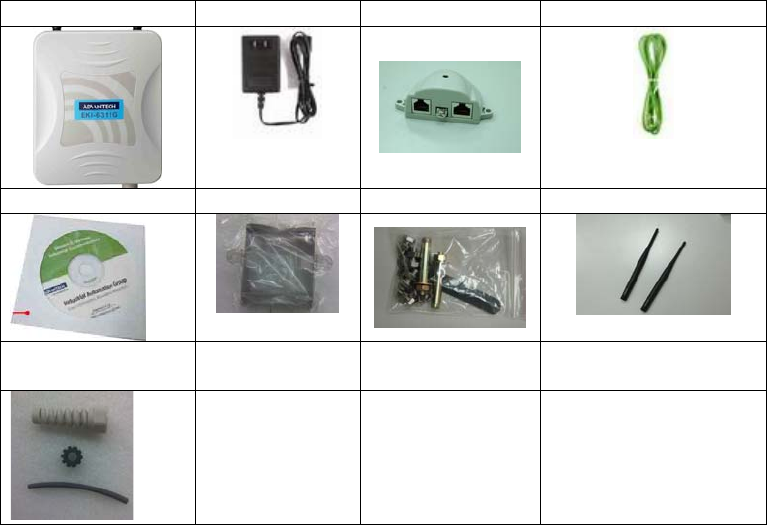
Chapter 2. Installation and Basic Configuration
This chapter describes the procedures of installing the EKI-6311g.
2.1 Before You Start
After unpacking the system, make sure the following items are present
and in good condition. Refer to below pictures for product image.
1. EKI-6311g Outdoor Wireless Access Point/Client Bridge unit
2. 100~240VAC, 50~60Hz AC to 48V/0.375A DC switching
adapter
3. Inline Power Injector (PoE) 48VDC, 0.375A
4. Grounding wire 1.8m
5. User manual CD-disc
6. Wall/mast mounting kit, including one (1) band clamp
7. Screws
8. 5dBi Oimi-type Antenna
9. RJ-45 cable waterproof cap
1. Unit 2. Adapter 3. PoE 4. Grounding wire
5. CD 6. Wall mount
7. Screws 8. Antenna
9. RJ-45 cable
waterproof cap
6
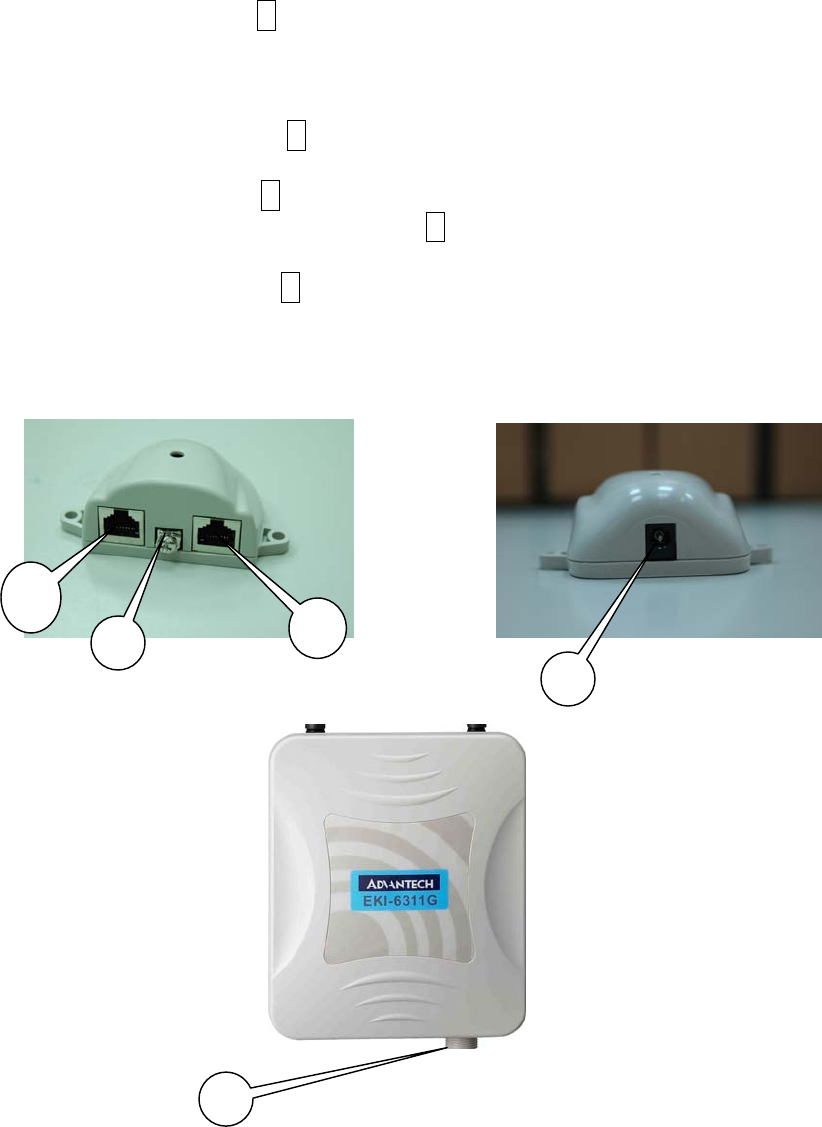
2.2 Locate the EKI-6311g and Inline Power Injector Ports 2.2 Locate the EKI-6311g and Inline Power Injector Ports
► Interface on the EKI-6311g Unit ► Interface on the EKI-6311g Unit
Ethernet Port 1 : for connecting the 30m RJ-45 CAT-5 Ethernet Port 1 : for connecting the 30m RJ-45 CAT-5
Ethernet cable.
► Interface on the Inline Power Injector
Data Input Port 2 : for connecting cross-over Ethernet Cable
to PC or straight Ethernet cable to Hub Switch Router .
DC Input Port 3 : power adapter 48V, 0.38A DC input.
Power & Data Output Port 4 : for connecting the 30m RJ-45
CAT-5 Ethernet Cable.
Grounding Port 5 : for connecting grounding wire.
Device
POE picture1 POE picture2
5
4
2
3
Figure 2-1
Power and Data Interface location on the PoE denoted by numbers 1-5.
1
7
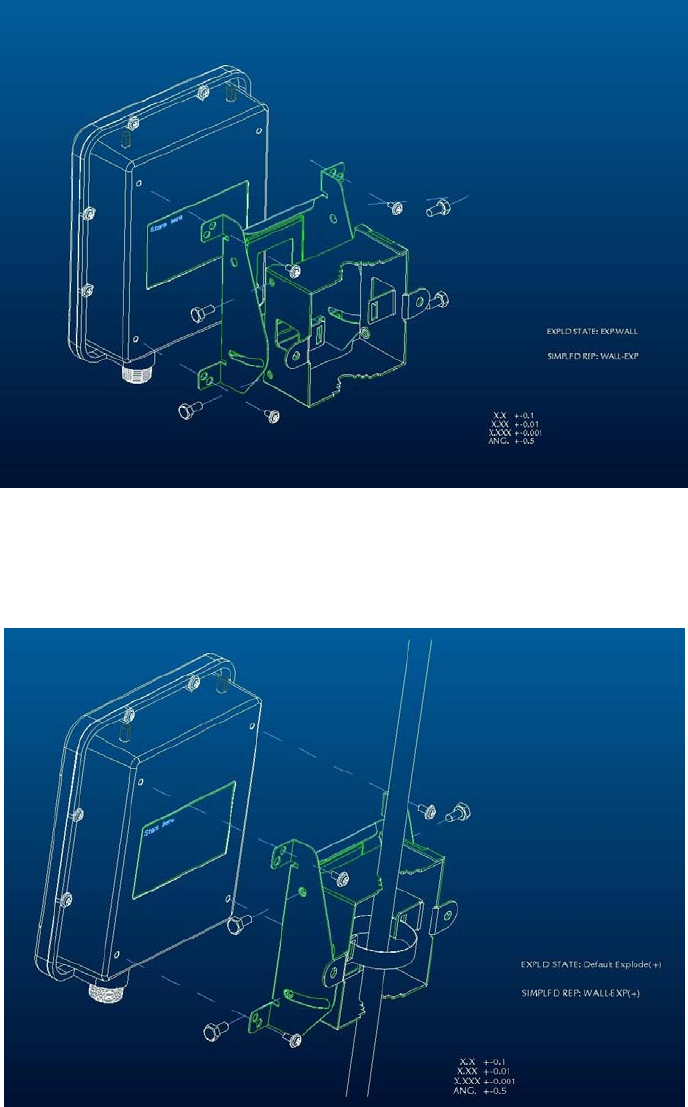
► Mount EKI-6311G on A Wall/Mast
The EKI-6311G can be mounted on the wall, you can use the Wall Mount
kit to mount the EKI-6311G as shown in Figure 2-2.
Figure 2-2
You can also mount the EKI-6311G to the mast as shown in Figure 2-3.
Figure 2-3
8
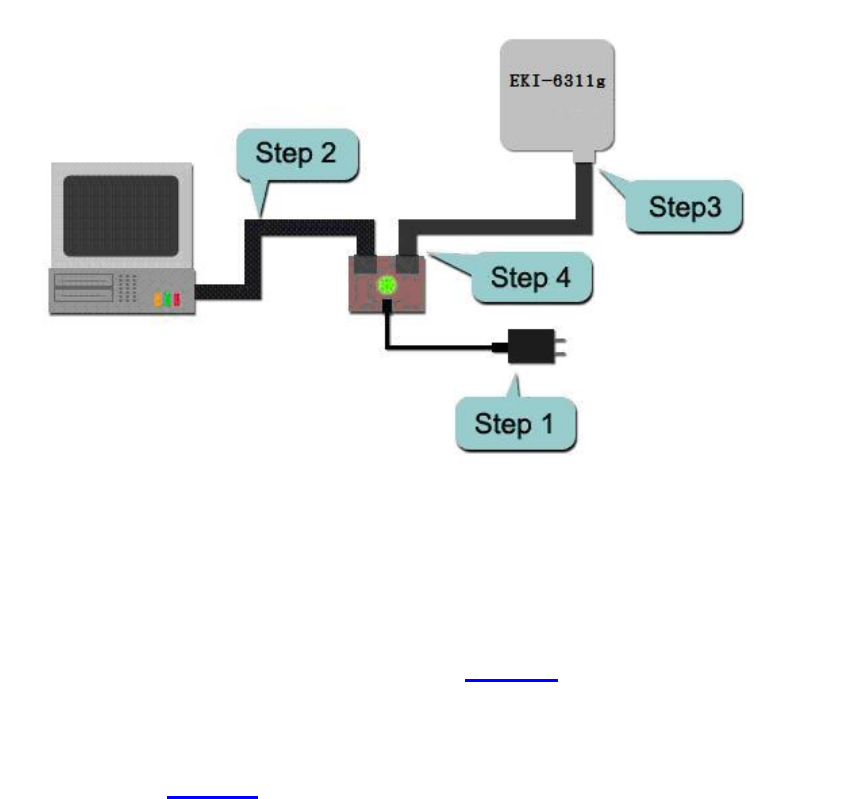
2.3 Preparing Installation
Before installing EKI-6311g for outdoor application or hard-to-reach
location, we recommend configuring and test all the devices first.
For configuring the EKI-6311g, please follow the quick steps below to
power up the EKI-6311g. Refer to Figure 2-4 for steps 1 through 5.
Figure 2-4
Step1 : Connect the DC plug of the AC/DC power adapter into the DC
Input Port of Inline Power Injector and the wall-mount plug into a
power outlet or power strip (refer to page 6). The Power LED on the
Inline Power Injector will light up.
Step2 : Run the cross-over type uplink Ethernet cable from Data Input
Port (refer topage 6) to the Ethernet port on PC.
Step3 : Connect the CAT 5 Ethernet cable into the EKI-6311g unit.
Hand tightens the connector.
Step4 : Connect the remaining end of the 30m CAT 5 cable into the PoE
labeled AP/Bridge. This is the power side of the PoE that will power up
the EKI-6311g.
9
When the EKI-6311g receives power over the Ethernet cable, the
EKI-6311g will start its boot up sequence.
You can configure the EKI-6311g via HTML browser, such as Microsoft
Internet Explorer or Netscape Navigator from a remote host or PC.
10
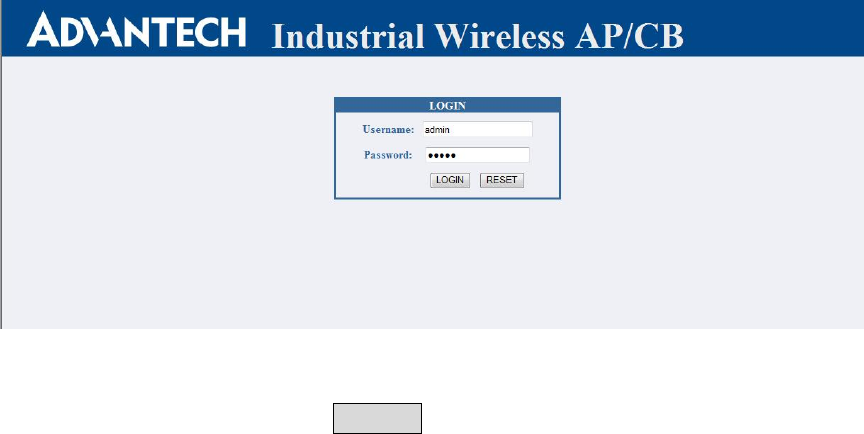
2.4 Basic Configuration
2.4.1 Logging into the Web Interface
The EKI-6311G supports access to the configuration system through the
use of an HTTP Interface.
► Web Configuration
Before configuring EKI-6311G, the user needs to know the IP Address
assigned to the unit. When shipped from the factory, the IP Address
192.168.1.1 was assigned to the EKI-6311G by default. To start a
web connection, use http://192.168.1.1
► Web Access Procedures
Once you identify the IP Address assigned to EKI-6311G, use web
browser to configure EKI-6311G through the HTTP Interface. The
following procedure explains how to configure each item.
Step1 : Open your browser and enter the IP Address
Step2 : Press <ENTER> key and the EKI-6311G Login screen appears
as shown in Figure 2-3.
Figure 2-3
Step3 : Enter “admin” in the Username. Enter “admin”in the
Password fields, and click Log In to enter the web configuration
user interface screen as shown below.
11
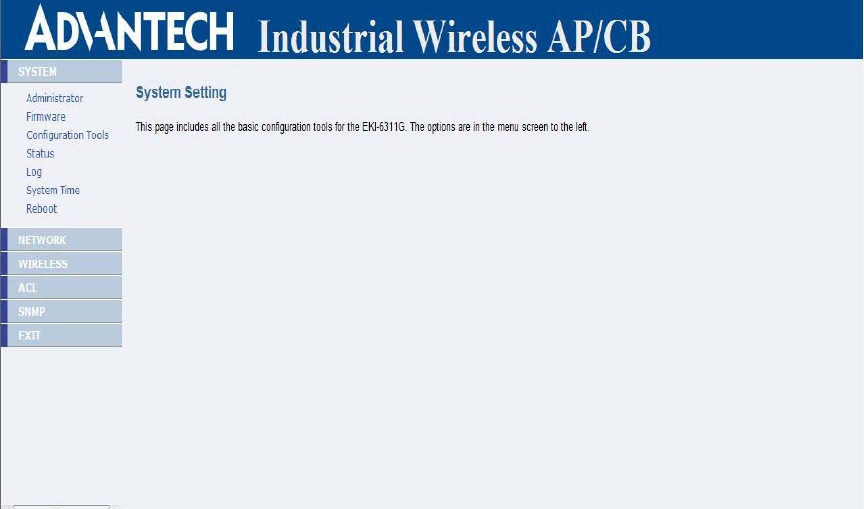
Figure 2-4
► Web Configuration Structure
The web configuration user interface shown above in Figure 2-4 is
grouped into a tree structure, and contains the following settings or
information.
▽ SYSTEM
● Administrator
● Firmware
● Configuration
● Status
● Log
● System Time
● Reboot
▽ NETWORK
● Network
● HotSpot
▽ WIRELESS
● Wi-fi 1
● Wi-fi 2
● Wi-fi 3
● Wi-fi 4
▽ ACL
12
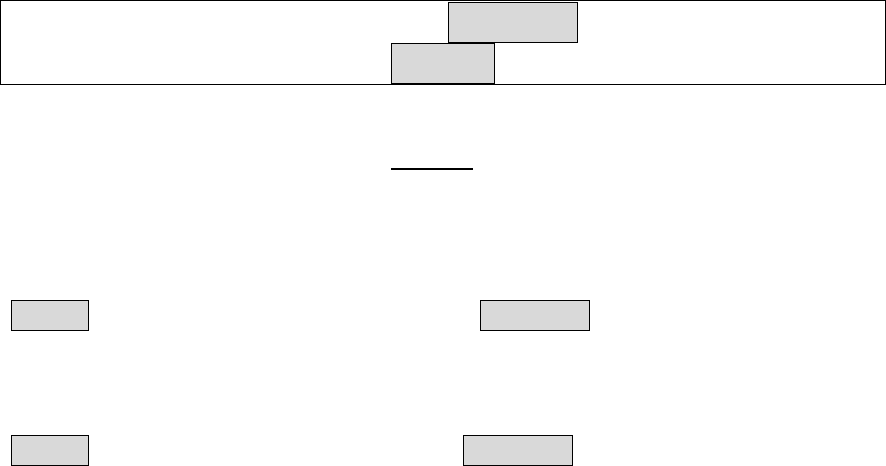
● ACL for Wi-fi 1
● ACL for Wi-fi 2
● ACL for Wi-fi 3
● ACL for Wi-fi 4
▽ SNMP
● Agent Settings
▽ EXIT
Move through the tree by clicking on an icon to expand or collapse the
tree. The nodes on the tree represent web pages that allow viewing and
modifying the parameters.
2.4.2 Basic Configuration Steps
Note: All setting changing must Reboot the device after click
Apply
This section describes two-step BASIC configuration procedures to setup
EKI-6311G.
Step1 : Modify the factory-default parameters on the web page
“/Network/Network/”, when changing any parameters, please click
Apply to save the changes, then click Reboot on the System page.
Step2 : Modify the factory-default parameters on the web page
“/Wireless/Wi-Fi 1/”, when changing any parameters, please click
Apply to save the changes, then click Reboot on the System page. to
take effect on the previous configuration changes.
13
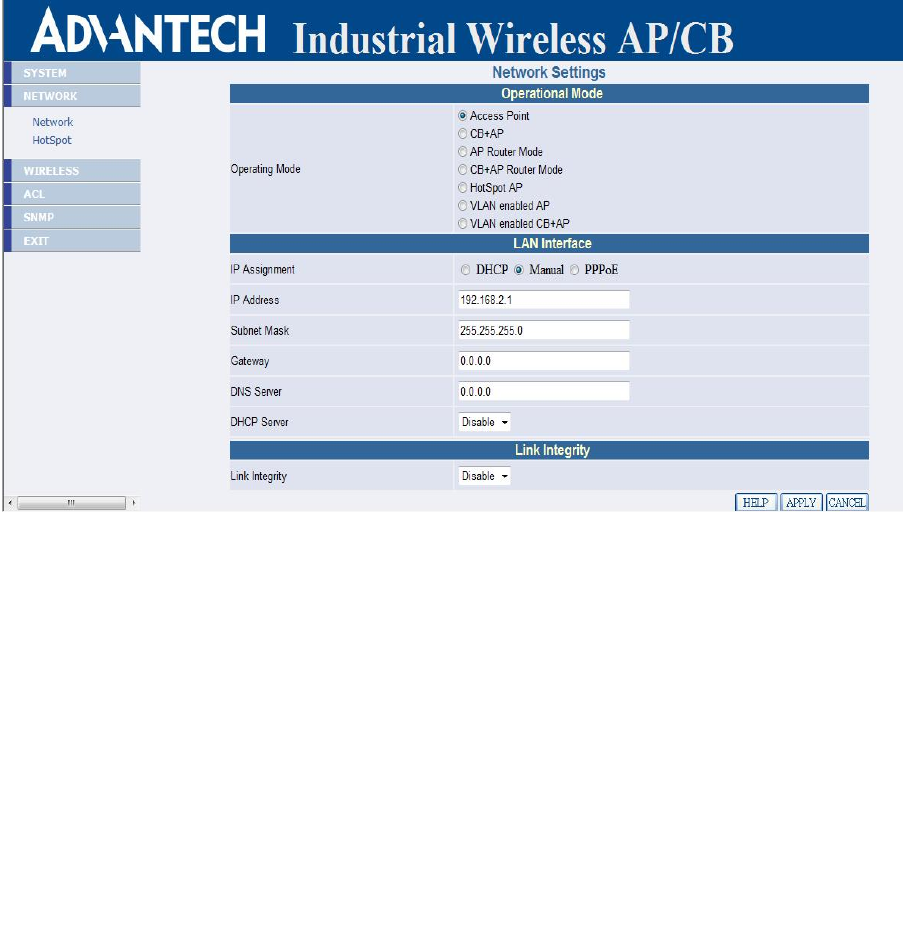
2.4.3 Set Operating Mode, IP Address, Subnet Mask, Default
Route IP, DNS Server IP of EKI-6311G
► LAN Settings
These are the settings of the LAN (Local Area Network) interface for the
Access Point. The Access Point's local network (LAN) settings are
configured based on the IP Address and Subnet Mask assigned in this
section. The IP address is also used to access this Web-based
management interface. This option is available in the “/NETWORK/
NETWORK /” page as shown in Figure 2-5.
.
Figure 2-5
► Get LAN IP From
Choose "DHCP (Dynamic)" if your router supports DHCP and you want
the router to assign an IP address to the AP. In this case, you do not need
to fill in the following fields. Choose "Static IP (Manual)" if your router
does not support DHCP or if for any other reason you need to assign a
fixed address to the AP. In this case, you must also configure the
following fields.
Note that you cannot choose "DHCP (Dynamic)" if you have enabled the
"DHCP Server" option on the DHCP page; the AP cannot be both a DHCP
client and a DHCP server.
14

► IP Address
The IP address of the AP on the local area network.
Assign any unused IP address in the range of IP addresses available for
the LAN.
For example, IP address: 192.168.1.100.
► Subnet Mask
The subnet mask of the local area network.
► Gateway
The IP address of the router on the local area network.
► DNS Server
This entry is optional. Enter a DNS Server for the local network.
15
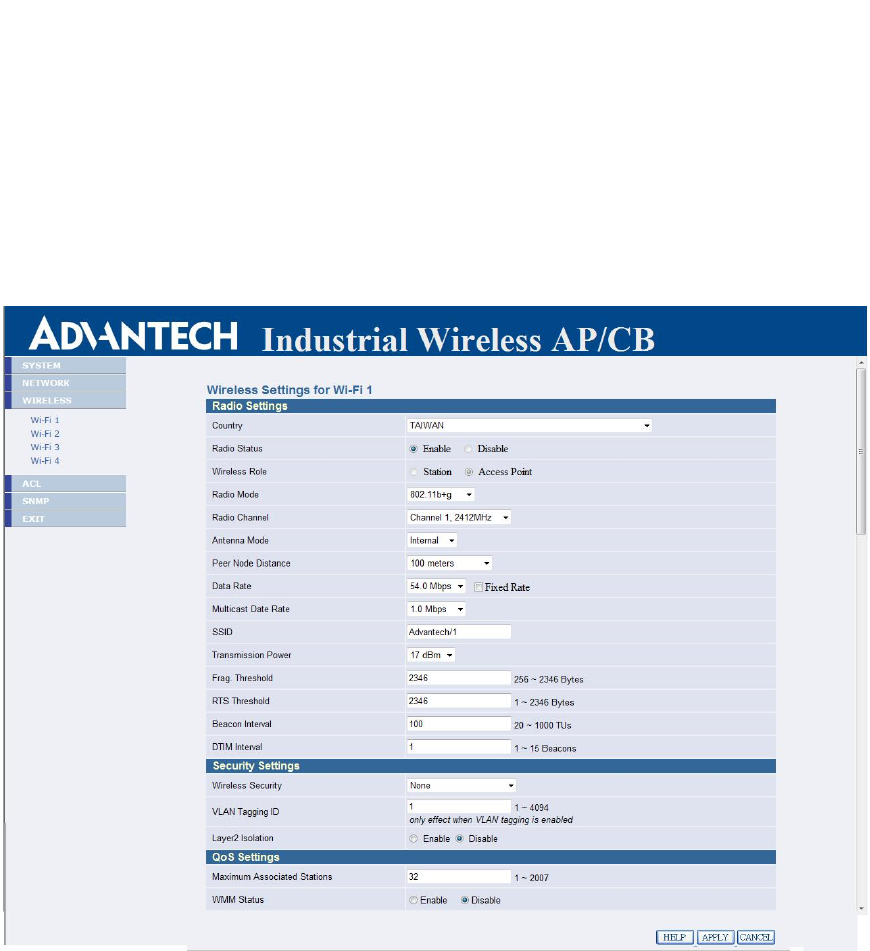
2.4.4 Set Wireless SSID for Wireless Interface
► Wireless Network Name (SSID)
When you are browsing for available wireless networks, this is the name
that will appear in the list (unless Visibility Status is set to invisible, see
below). This name is also referred to as the SSID. For security purposes,
it is highly recommended to change from the pre-configured network
name. This option is available in the “/WIRELESS/Wi-Fi 1/” page as
shown in Figure 2-6.
**Default SSID: “EKI-6311G” in wifi-1.
** Radio Channel only supports channel 1 to channel 11 in USA
Figure 2-6
16
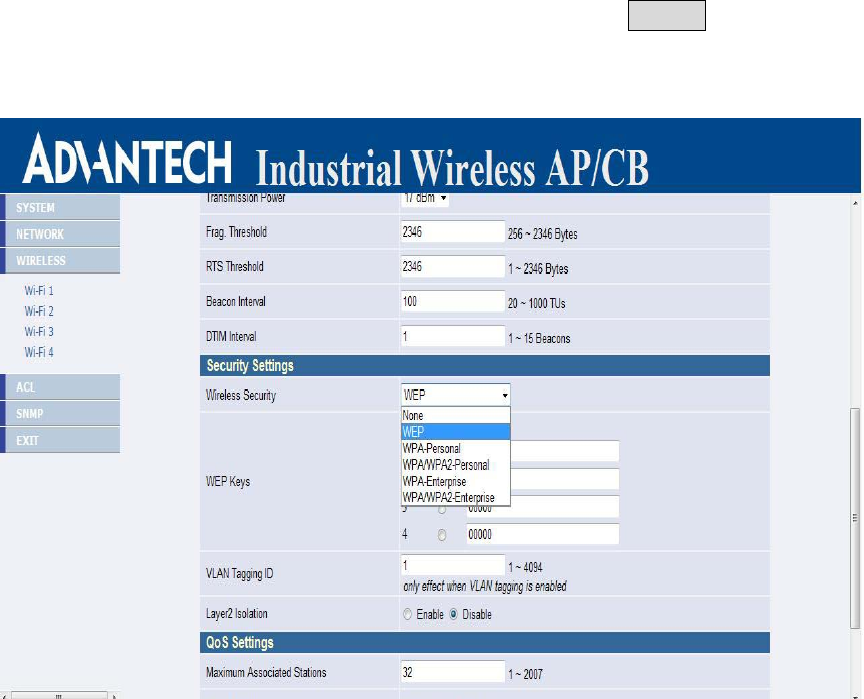
2.4.5 Set Wireless Encryption for Wireless Interface
The EKI-6311G supports 64-bit and 128-bit WEP encryption.
For 64-bit WEP encryption, an encryption key is 10 hexadecimal
characters (0-9 and A-F) or 5 ASCII characters.
For 128-bit WEP encryption, an encryption key is 26 hexadecimal
characters or 13 ASCII characters.
Modify the WEP encryption parameters on the web page
“/WIRELESS/Wi-Fi 1/Wireless SECURITY”. Choice “WEP” Enter
1~15 characters into the WEP Key field, then click Apply to save the
new parameter and Reboot the device . Page as shown in Figure 2-7
Figure 2-7
17
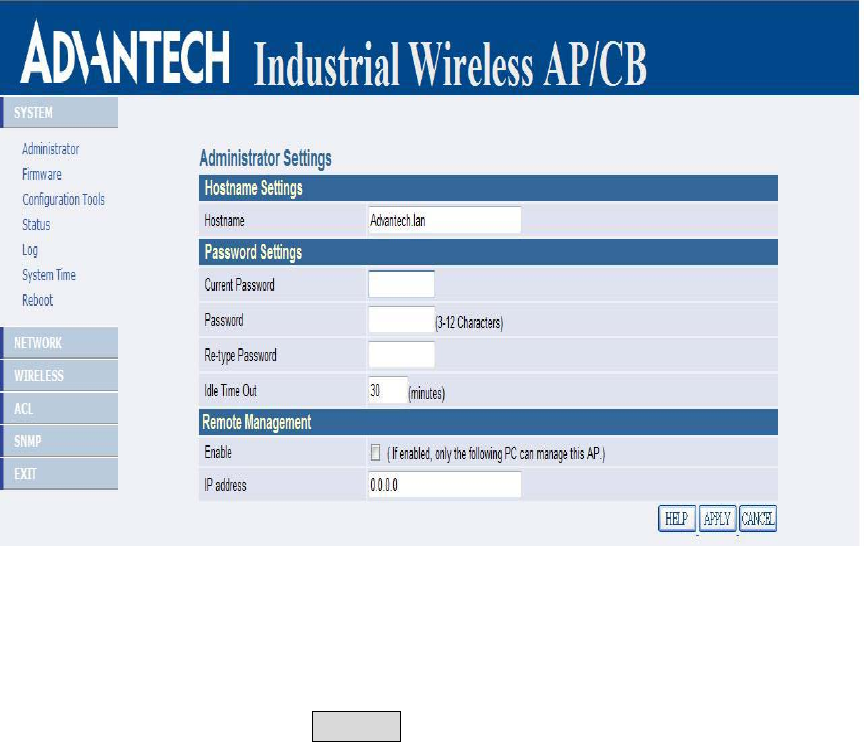
2.4.6 Change Supervisor Account & Password
Enter the SYSTEM > Administrator page. Figure 2-8 below shows the
SYSTEM / Administrator page.
Figure 2-8
► ADMIN PASSWORD Changing
Enter current password in the SYSTEM / Administrator / Password
Setting Current Password field. Enter new password in the
“PASSWORD and Re-type Password” field for changing new
password. Then and click APPLY and reboot the device.
18
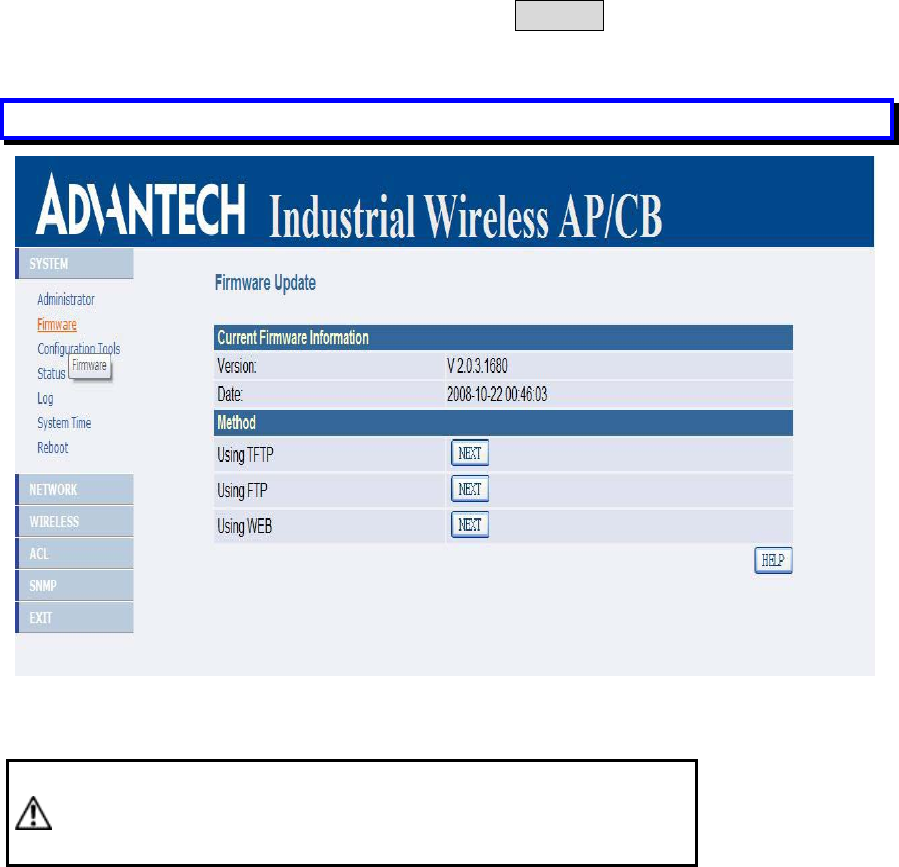
2.4.7 pgrade the Firmware
► Update the Firmware
Enter the SYSTEM > FIRMWARE page as shown in Figure 2-9 to
upgrade EKI-6311G. Here, user must select which file you want to
upgrade it (Program image), then click APPLY button to start the
upgrade process.
Hint: It takes about 10 min, to complete the restart process.
Figure 2-9
Caution The Part 15 radio device operates on a non-interference basis with
other devices operating at this frequency when using integrated antennas. Any
changes or modification to the product not expressly approved by Original
Manufacture could void the user's authority to operate this device.
.
19
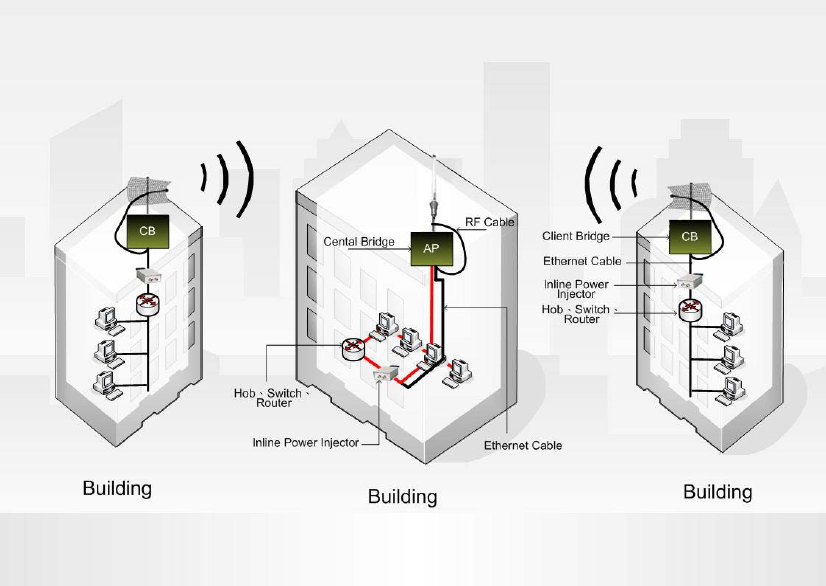
Chapter 3. Network Topologies
This chapter describes several common types of installations
implemented by using the EKI-6311g’s line of Outdoor Wireless System.
This is by no means intended to be an exhaustive list of all possible
configurations, but rather shows examples of some of the more common
implementations. The EKI-6311g CB can be configured to function as a
Wireless Client Router or Bridge to a central access point like the
EKI-6311g AP see Figure 3-1 below.
Figure 3-1
The EKI-6311g CB performs in either router or bridge mode. In a
Point-to-Multipoint topology, all communication between network systems is done
through a centralized agent. Among the EKI-6311g Outdoor Wireless Bridge
products, the centralized agent is Central Bridge (EKI-6311g AP) and the individual
network notes may be Bridge (EKI-6311g CB ).
To show the available Point-to-Multipoint topologies, the following examples are
provided.
20
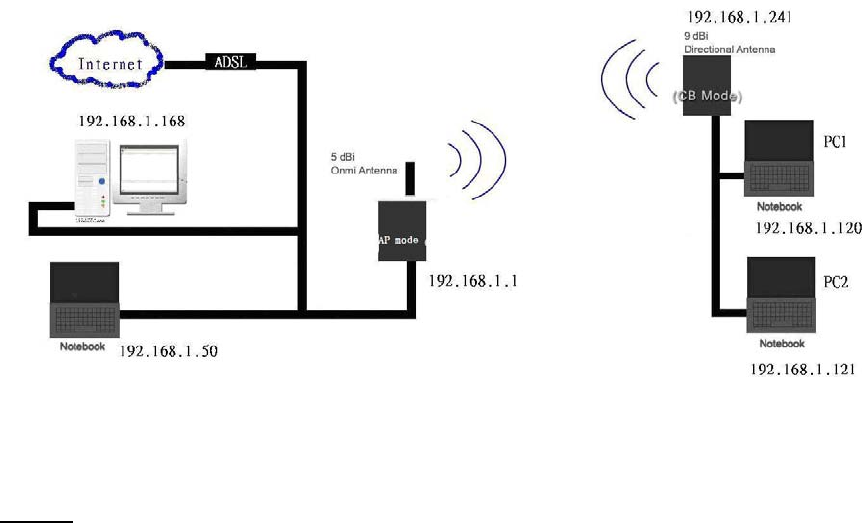
3.1 Wireless Client Bridge-to-Central Wireless Bridge
Figure 3-2
Refer to Figure 3-2 for the following setup.
Note: The EKI-6311G AP mode is the Central Wireless Bridge and
EKI-6311G CB is the Wireless Client Bridge
Step 1 Set the EKI-6311G AP mode to perform a bridge (example : IP
address: 192.168.1.1).
Step 2 Set Wireless parameters on the AP to: Channel (1) and SSID
(EKI-6311G)
Step 3 Set the EKI-6311G CB to function in the bridge mode (bridge IP
address: 192.168.1.241).
Step 4 Set Wireless parameters on the EKI-6311G CB to: Channel (1)
and SSID (EKI-6311G), and these parameters must be the same with
COU.
Step 5 Left side subnet is transparent to the right side.
Step 6 DHCP server assign IP address to PC1 and PC2.
21
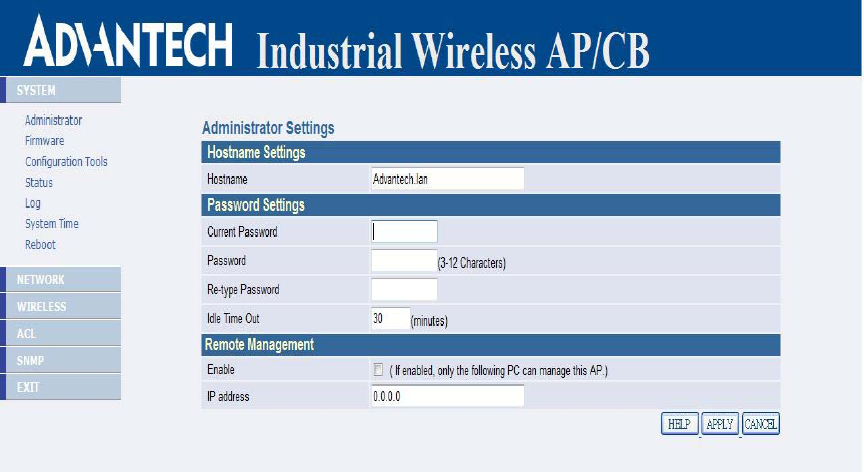
Chapter 4. All function on Device
4.1 SYSTEM
4.1.1 Administrator
Administrator Settings
Use this menu to restrict management access based on a specific
password. The default password comes with the installation guide.
Please change this password as soon as possible, and store it in a safe
place. Passwords can contain from 3-12 alphanumeric characters, and
are case sensitive.
Figure 4-1
Administrator Time-out
The amount of time of inactivity allowed before the user proceeds next
action. The user needs to re-login if the idle time passes timeout.
Remote Management
By default, management access is only available to users on your local
network. However, you can also manage the Wireless CPE from a remote
host. Just check the Enable box and enter the IP address of an
administrator to this screen.
22
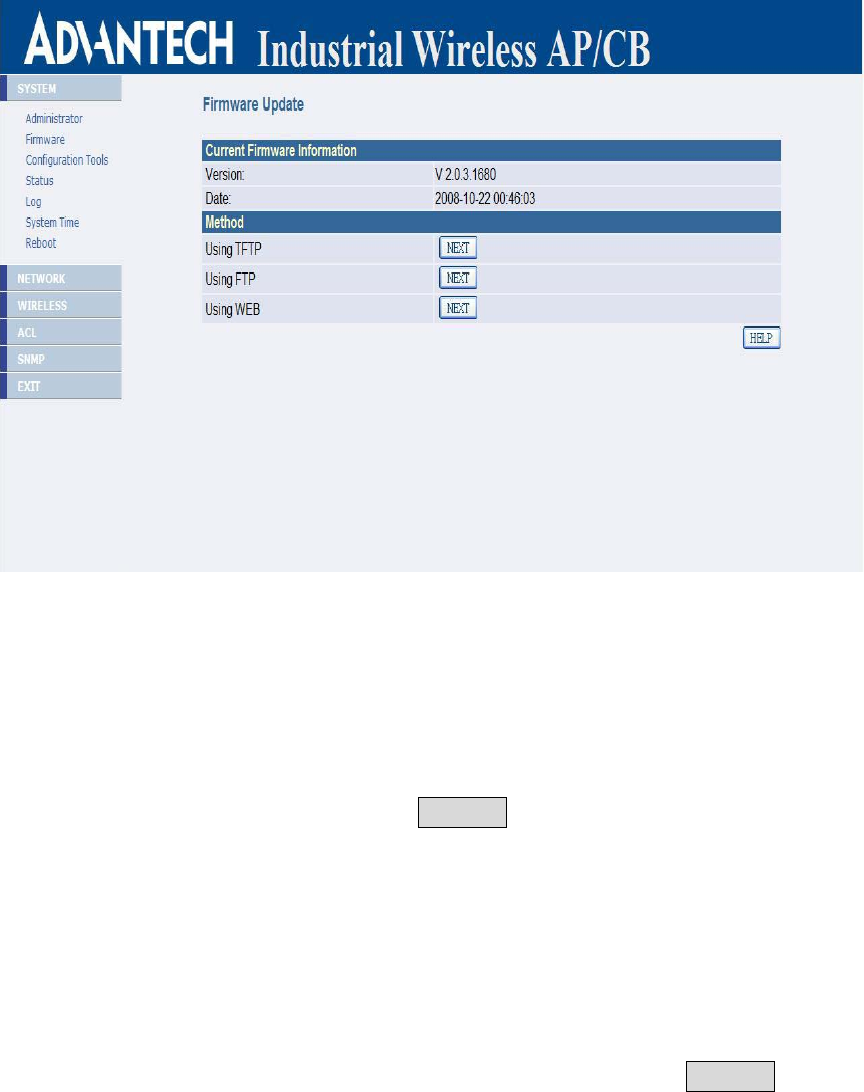
4.1.2 Firmware
Figure 4-2
Firmware Update – TFTP/FTP
You can use TFTP to upgrade the firmware. The "firmware information"
displays current firmware version and firmware date. On the managed
computer, run the TFTP Server utility. And specify the folder in which the
firmware file resides. After running the TFTP server, enter the TFTP
server IP and the filename. Click APPLY to complete your change. At
the end of the upgrade, the Wireless CPE may not respond to commands
for as long as ten minute. This is normal behavior and do not turn off the
Wireless CPE during the time.
Firmware Update - WEB
You can use WEB to upgrade the firmware. The "firmware information"
displays current firmware version and firmware date. Enter FTP Server
IP , Type the correct firmware file path and file name on the File field.
Keyin the current FTP Username and Password. Click on APPLY to
complete your change. At the end of the upgrade, the Wireless CPE may
not respond to commands for as long as ten minute. This is normal
behavior and do not turn off the Wireless CPE during the time.
23
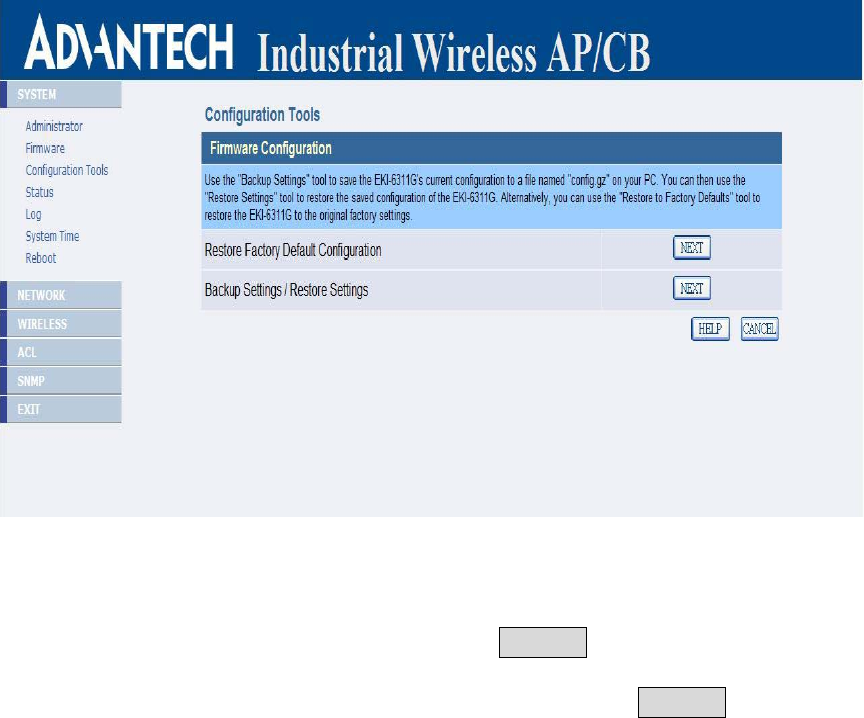
4.1.3 Configuration Tools
Figure 4-3
Restore Factory Defaults - Reset the CPE's configuration settings to
the factory default values. Check the "Restore Factory Default
Configuration" radio button then click on APPLY button.
Backup settings/Restore settings - Check the "Backup
settings/Restore settings" radio button then click on APPLY button.
Backup Settings - Press the "Backup Settings" button to save the
settings of this device to a file named "config.bin" on your PC.
Restore Settings - Restore the settings of this device to the backup
settings. Enter the path and name of the backup file then press the
"Restore Settings" button. You will be prompted to confirm the backup
restoration.
24
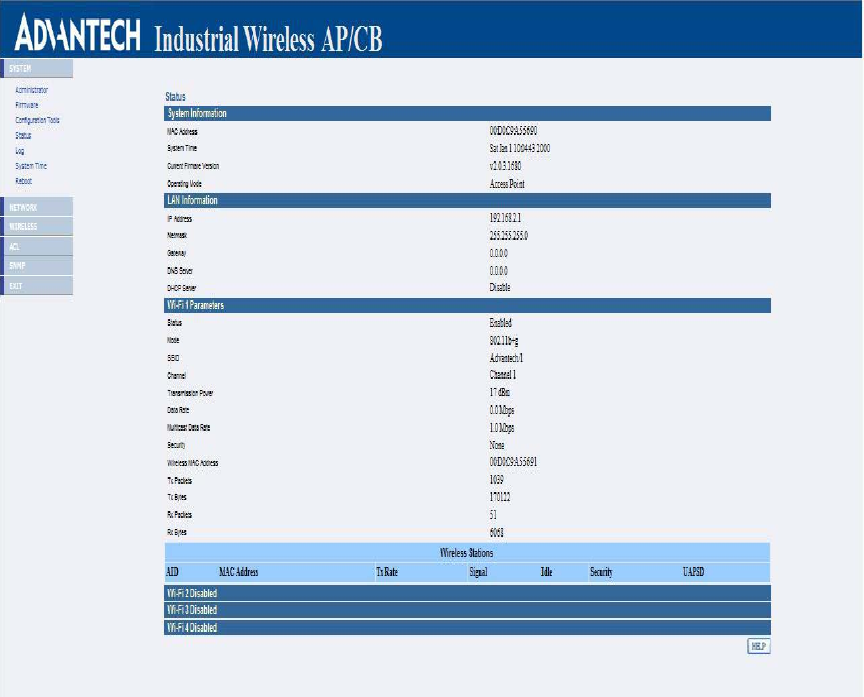
4.1.4 Status
Figure 4-4
You can use the Status screen to see the connection status for the LAN
and Wireless LAN interfaces. It also displays system up time and
firmware version.
The following items are included in this screen:
SYSTEM INFORMATION - Displays MAC address, System time,
Current firmware version and operation mode.
LAN INFORMATION - Displays IP settings of LAN port, including IP
Address and Subnet Mask.
WIRELESS INFORMATION - Displays wireless information, including
SSID, channel, Security status, and RF output power.
SYSTEM INFORMATION - Displays the system up time, the Wireless
CPE's firmware version, and the serial number.
25
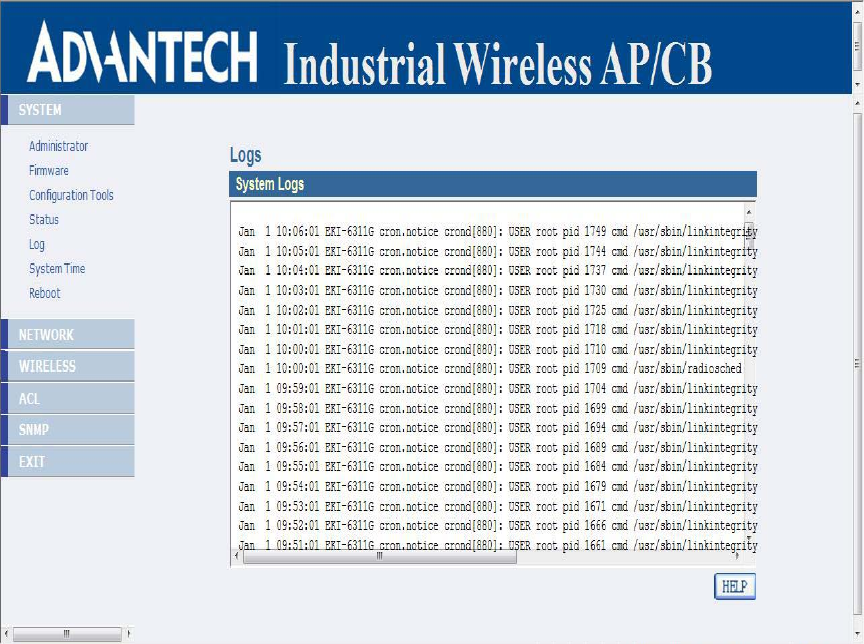
4.1.5 Log
Figure 4-5
The Access Point automatically logs (records) events of possible interest
in its internal memory. If there is not enough internal memory for all
events, logs of older events are deleted, but logs of the latest events are
retained. The Logs option allows you to view the Access Point logs.
26
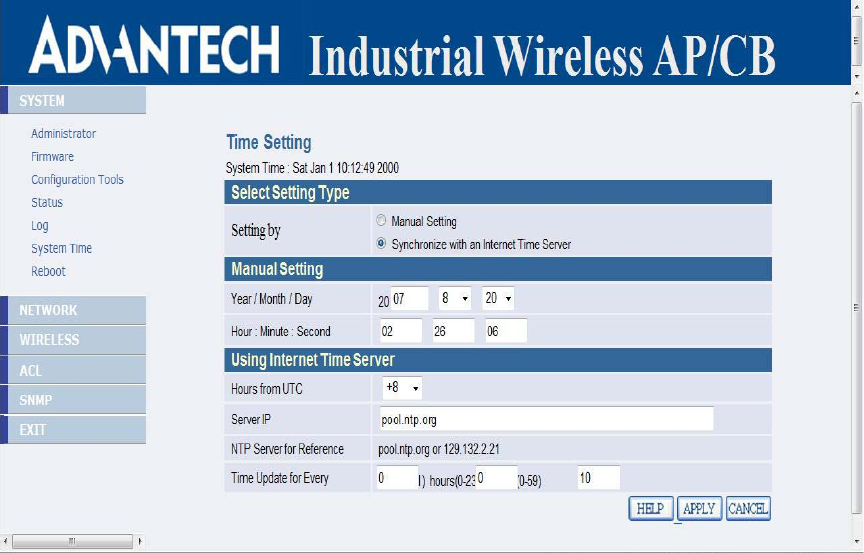
4.1.6 System Time
Figure 4-6
The Time Configuration option allows you to configure, update, and
maintain the correct time on CPE's internal system clock. From this
section you can set the time zone that you are in and set the Time Server.
Time Configuration- Set the Date and Time Manually. If you do not
have the NTP Server option in effect, you can either manually set the
time for your Access Point here.
Note: If the Access Point loses power for any reason, it cannot keep its
clock running, and will not have the correct time when it is started again.
To maintain correct time for schedules and logs, you must enter the
correct time after you restart the Access Point.
27
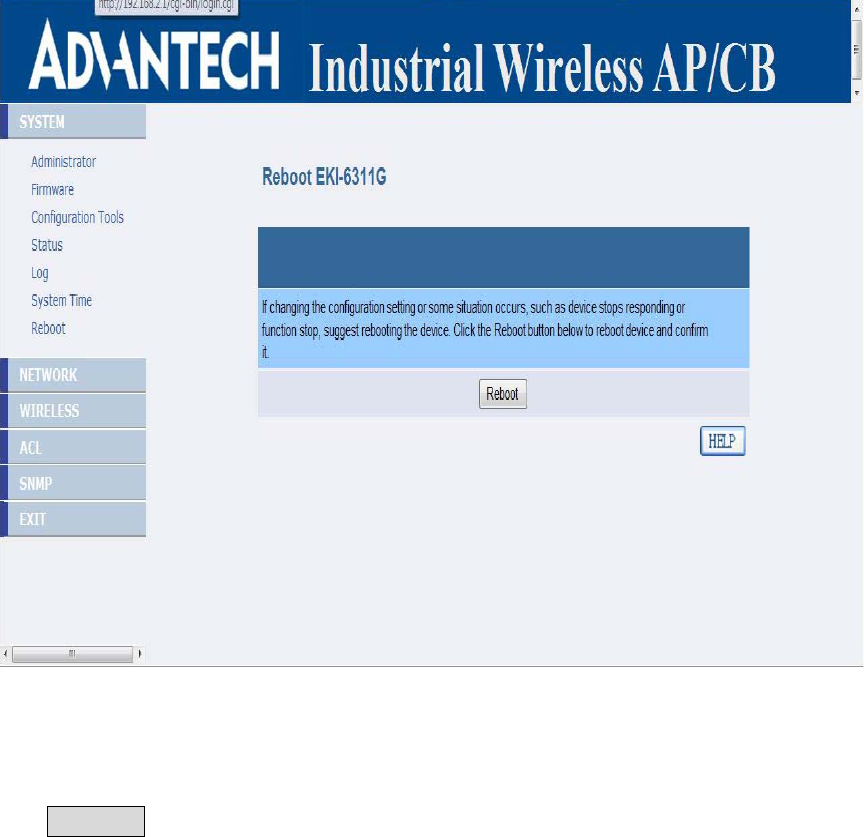
4.1.7 Reboot
Figure 4-7
Reset Wireless CPE. In the event that the Wireless CPE stops responding
correctly or in some way stops functioning, you can perform a reboot.
Your existing settings will not be changed. To perform the reset, click on
the Reboot button. You will be asked to confirm your decision.
28
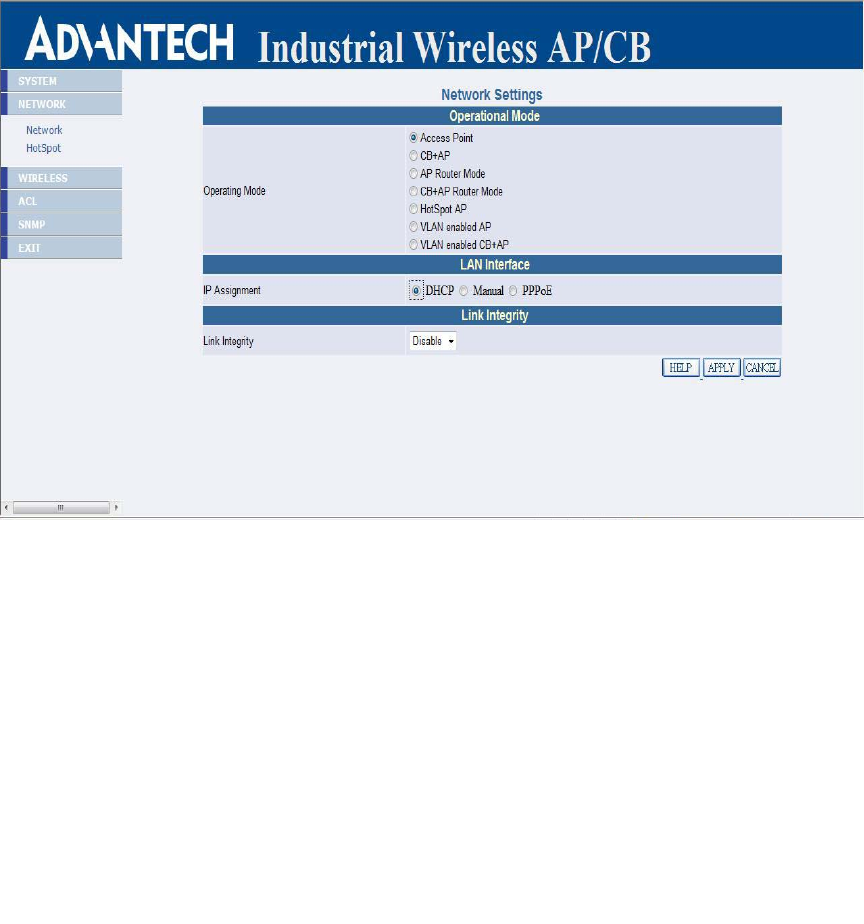
4.2 NETWORK
4.2.1 Network
4.2.1.1 Operating Mode-Access Point
IP Assignment
DHCP
Choose "DHCP (Dynamic)" if your router supports DHCP and you
want the router to assign an IP address to the AP. In this case, you
do not need to fill in the following fields.
Figure 4-8
Manual
Choose "Manual" if your router does not support DHCP or if for any
other reason you need to assign a fixed address to the AP. In this
case, you must also configure the following fields.
IP Address
The IP address of the AP on the local area network. Assign any
unused IP address in the range of IP addresses available for the
LAN. For example, 192.168.2.1.
29
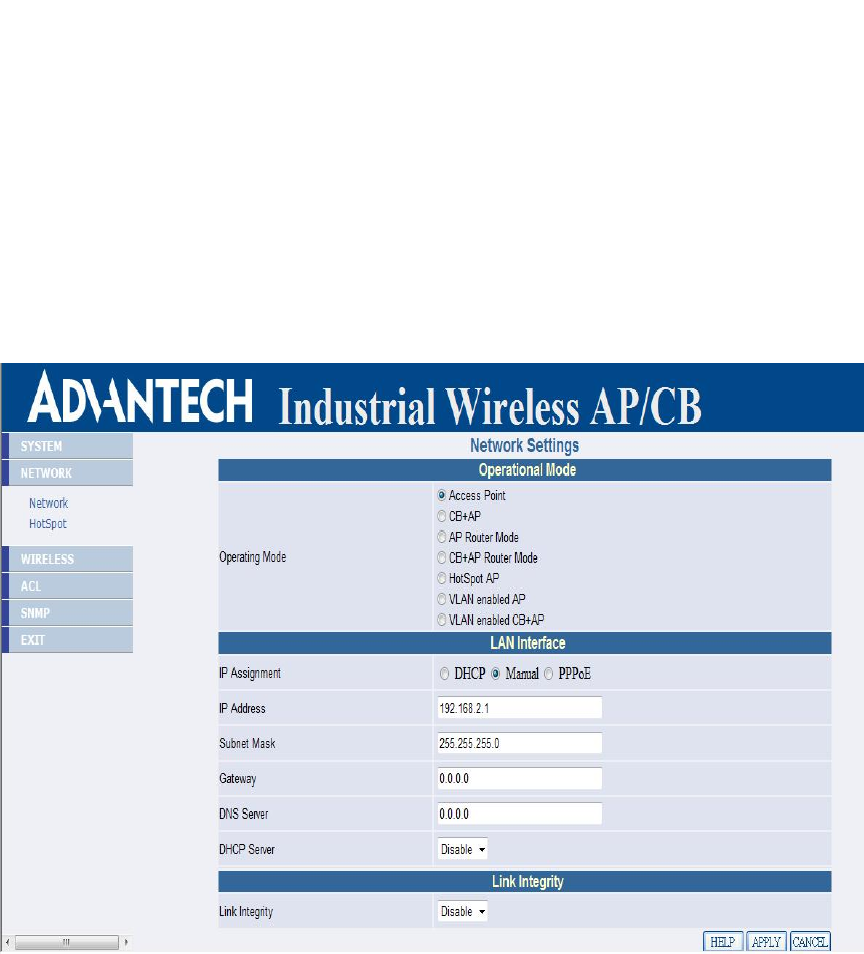
Subnet Mask
The subnet mask of the local area network.
Gateway
The IP address of the router on the local area network.
DNS Server
DNS (Domain Name System), Penetrates the DNS system, We
may look up its IP by machine domain name, Also may instead look
up its domain name by machine IP
This entry is optional. Enter a DNS Server for the local network.
Figure 4-9
30
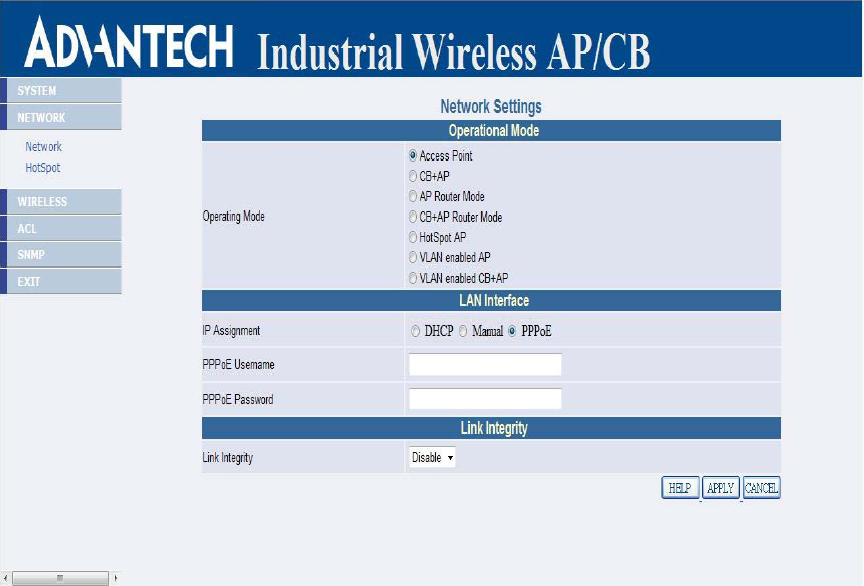
PPPoE
Choose "PPPoE" if your Internet support PPPoE Server .You need
keyin Username and Password to login PPPoE Server.
Figure 4-10
4.2.1.2 Operating Mode-Access Point
4.2.1.3 Operating Mode-CB+AP
4.2.1.4 Operating Mode-AP Router
4.2.1.5 Operating Mode-Access Point
4.2.1.6 Operating Mode-CB+AP Router
4.2.1.7 Operating Mode-Hot Spot
31
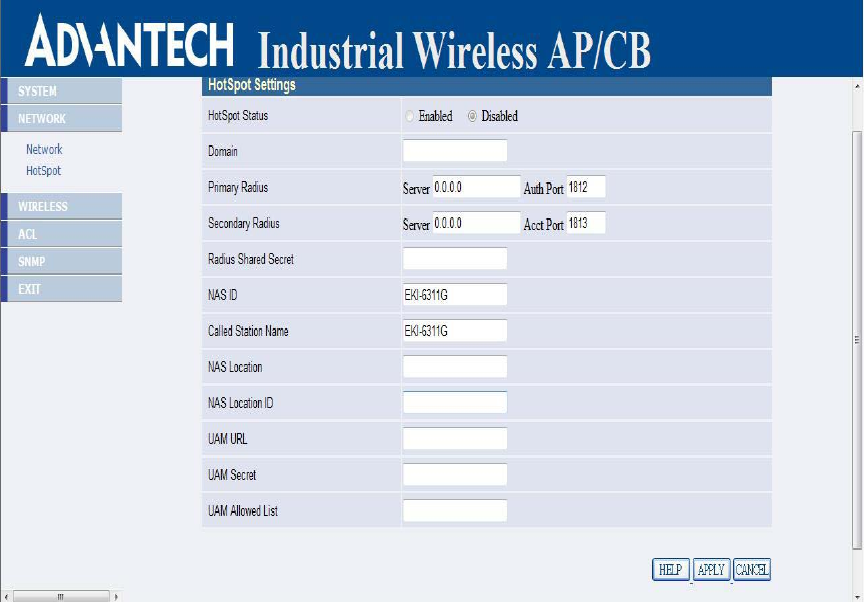
4.2.2 HotSpot(Captive Portal)
HotSpot: Enable/Disable captive portal function. Note, the CPE will
become router mode and ALL ssid in Access Point role after HotSpot
enabled.
Domain: Set domain name for hotspot.
Primary Radius: Set primary radius server for hotspot user
authentication.
Secondary Radius: Set backup radius server for hotspot user
authentication.
NAS ID: Set CPE's NAS ID in RADIUS frames.
Called Station Name: Set CPE's station name in RADIUS frames.
NAS Location: Set CPE's location name in RADIUS frames.
NAS Location ID: Set CPE's location ID in RADIUS frames.
UAM Server: The URL for hotspot user login.
UAM Secret: The encryption key between UAM server and CPE.
UAM Allowed List: IPs/Hostnames that hotspot can visit before login.
Figure 4-11
32
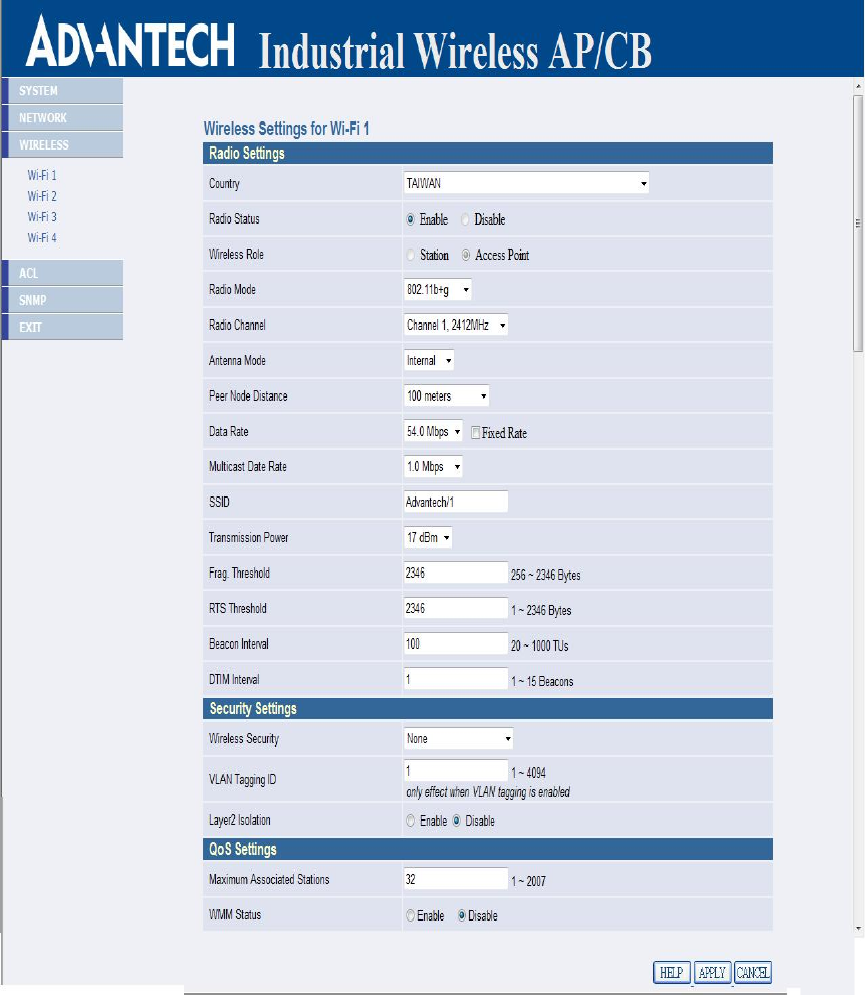
4.3 WIRELESS
You can set the wireless related setting here
Figure 4-12
33
** Radio Channel only supports channel 1 to channel 11 in USA
4.3.1 Wi-Fi 1
Wireless Settings
Radio Status: Enable/Disable SSID.
Wireless Role: This SSID will act as Station or Access Point. Note: only
first SSID can act as station.
Radio Mode: Set 11g, 11b or 11b+g mode.
Radio Channel: Select radio channel or use auto.
Peer Node Distance: Set distance between this CPE and it's adjacent.
SSID: Set (extended) service set ID, a.k.a. network name.
Transmission Power: Set transmission power in dBm, Note: H/W may
not transmit power as high as you set, depends on H/W faculty.
VLAN Tagging ID: Set this SSID's VLAN tag when VLAN tagging
enabled.
Maximum Associated Stations: Restrict maximum number of
associated stations.
Layer 2 Isolation: Prevent packets exchange between associated
stations.
Frag. Threshold: Fragmentation threshold.
RTS Threshold: RTS threshold.
Beacon Interval: Beacon interval in TUs.
WMM Tx: Set WMM parameters for packet transmission.
WMM Station: Set WMM parameters that provide for station.
Security:
WEP: Set WEP key in hexadecimal
WPA-Personal: WPA with pre-shared key.
WPA/WPA2-Personal: WPA and WPA2 co-existence with pre-shared
key.
WPA-Enterprise: WPA, key provided by RADIUS server.
WPA/WPA2-Enterprise: WPA and WPA2 co-existence, key provided by
RADIUS server.
4.3.2 Wi-Fi 2
4.3.3 Wi-Fi 3
4.3.4 Wi-Fi 4
34
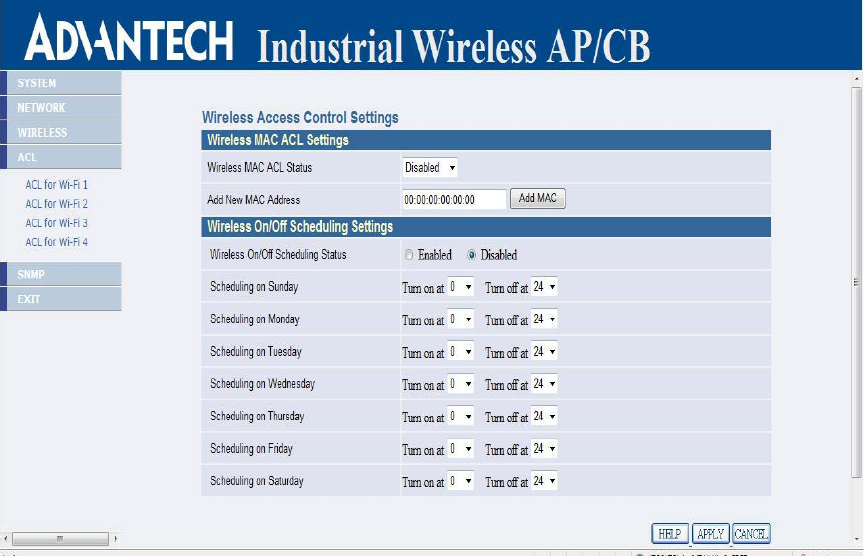
4.4 ACL
You can set the access control related setting here
Figure 4-13
4.4.1 ACL for Wi-Fi 1
Wireless MAC ACL
Wireless MAC ACL Status: Enable/Disable ACL by MAC address.
Add New MAC Address: Add a new MAC address to MAC table and in
active status.
MAC Table: Active, this MAC will be checked. Inactive, this MAC will
ignore for checking.
4.4.2 ACL for Wi-Fi 2
4.4.3 ACL for Wi-Fi 3
4.4.4 ACL for Wi-Fi 4
35
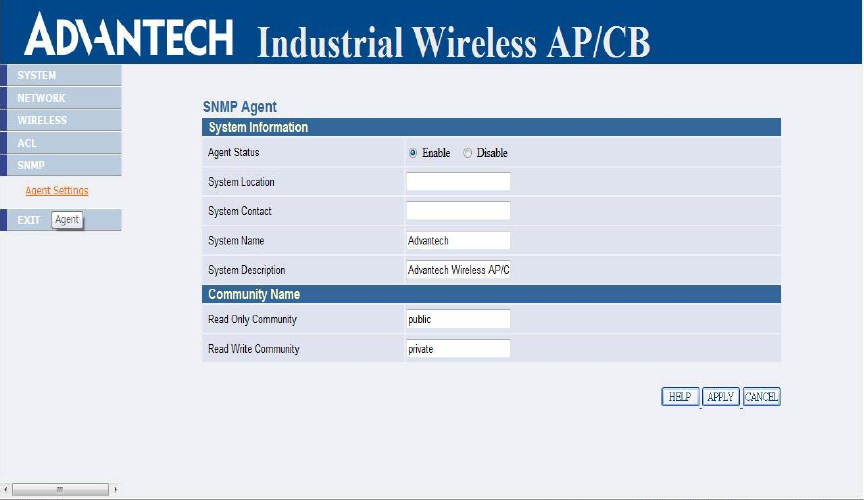
4.5 SNMP
You can set the SNMP Community and SNMP Trap setting here
4.5.1 Agent Settings
SNMP Agent provides a simple protection. Access to the SNMP device is
controlled through community names. The community name can be
thought of as a password. If you don't have the correct community name,
you can't retrieve any data (get) or make any change (set). Multiple
SNMP managers may be organized in a specified community. You can
change your SNMP community settings on this screen. Check the
“Enable” check box to turn on SNMP daemon. Click APPLY to complete
your change.
Read Only Community: Specify the name of community for read only
access.
Read Write Community: Specify the name of community for read and
write access.
Figure 4-14
4.6 EXIT
36
Chapter 5. Specifications
The EKI-6311G Outdoor Wireless Multi-Client Bridge/Access Point
operates seamlessly in the 2.4 GHz frequency supporting the IEEE
802.11b/802.11g wireless standards. It's the best way to add wireless
capability to your existing wired network, or to add bandwidth to your
existing wireless installation.
To secure your wireless connectivity, it can encrypt all wireless
transmissions through 64/128-bit WEP data encryption and also
supports WPA/WPA2(Personal/Enterprise). ACL lets you select exactly
which stations should have access to your network. With the Wireless
Multi-Client Bridge/Access Point, you'll experience the best wireless
connectivity available today.
37

38
Features
High Speed Data Rate Up to 54Mbps
Output Power up to 17dBm ± 2dBm
IEEE 802.11b/g Compliant
Access Point / CB+AP / AP Router / CB+AP Router / HotSpot AP / VLAN AP /
VLAN CB+AP
WEP/WPA/WPA2/ IEEE 802.1x Authenticator support
Dust tight and Watertight and Weatherproof (IP67)
Wide temperature range and robust mechanical design
Power-over-Ethernet (IEEE802.3af Compliant)
Technical Specifications
Data Rates 1, 2, 5.5, 6, 9, 11, 12, 18, 24, 36, 48, 54 Mbps
Standards IEEE802.11b/g, IEEE802.1x, IEEE802.3,
IEEE802.3u
Compatibility IEEE 802.11g/ IEEE 802.11b
Power
Requirements Active Ethernet (802.3af) – 48 VDC/0.35A
Regulation
Certifications FCC Part 15/UL, ETSI 300/328/CE
RF Information Atheros BB/MAC/RF
Frequency Band 2.400~2.484 GHz
Media Access
Protocol Carrier Sense Multiple Access with Collision
Avoidance (CSMA/CA)
Modulation
Technology Ortho
g
onal Frequency Division Multiplexin
g
(OFDM),
DBPSK @ 1Mbps,
DQPSK @2Mbps,
CCK @ 5.5 & 11Mbps,
BPSK @ 6 and 9 Mbps,
QPSK @ 12 and 18 Mbps,
16-QAM @ 24 and 36 Mbps,
64-QAM @ 48 and 54 Mbps
Operating Channels 11 for North America, 14 for Japan, 13 for Europe
Receive Sensitivity
(Typical) -72dBm @ 54Mbps
Available transmit
power(Typical) 17dBm±2dBm @1, 2, 5.5 and 11Mbps,
17dBm±2dBm @6Mbps,
14dBm±2dBm @54Mbps
Antenna 5dBi External

39
RF Connector SMA Type
Networking
Topology Ad-Hoc, Infrastructure
Operation Mode Access Point / CB+AP / AP Router / CB+AP Router /
HotSpot AP / VLAN AP / VLAN CB+AP
Interface One 10/100Mbps RJ-45 LAN Port , RS-232 Console
Security IEEE802.1x authenticator /RADIUS client
(EAPMD5/TLS/TTLS) support in AP mode WPA / Pre
Share KEY (PSK)/TKIP MAC address filtering Hide
SSID in beacons Layer 2 Isolation
IP
Auto-configuration DHCP client/server/PPPoE
Management
Configuration Web-based configuration (HTTP)
Firmware Upgrade Upgrade firmware via web browser
Physical Dimensions 209.1(L)mm * 165.4(W)mm * 61.5(H)mm
Weight AP: 500g (1.1 lbs); CB: 600g (1.3 lbs)
Environmental
Temperature Range -Operating: -10°C to 60°C (14°F to 140°F)
-Storage: -20°Cto 70°C (-4°F to 158°F)
Humidity
(non-condensing) 5%~95% Typical
Package Contents Water tight Outdoor Wireless Client Bridge unit
48V, 0.38A AC/DC adapter with wall-plug power
code
Inline Power Injector (PoE)
User’s manual CD-ROM
Wall mounting kit
Mast mounting kit
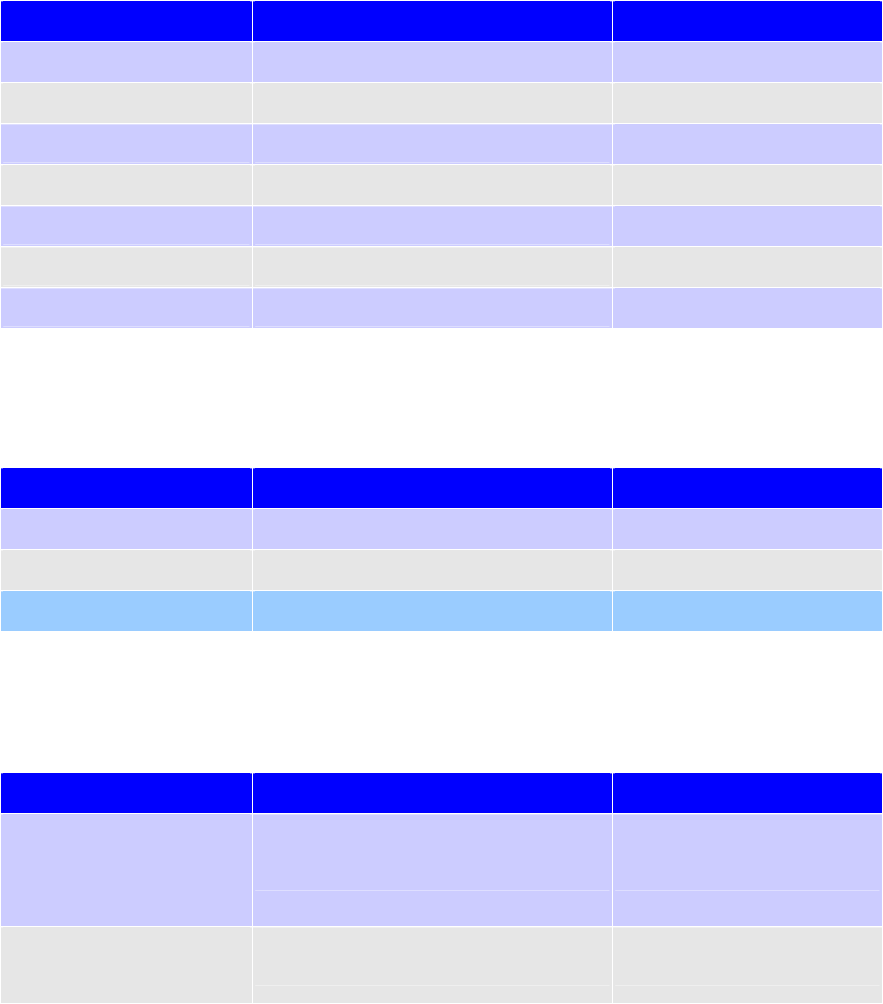
40
Chapter 6. Default Settings
6.1 SYSTEM
6.1.1 Administrator
Parameter Description Default Value
Hostname Advantech.lan
Current Password
Password
Re-type Password
Idle Time Out 30
Enable
IP address 0.0.0.0
6.1.2 Firmware
Parameter Description Default Value
Using TFTP
Using FTP
Using WEB
6.1.3 Configuration Tools
Parameter Description Default Value
Restore Factory
Default
Configuration
Backup Settings /
Restore Settings
6.1.4 Status
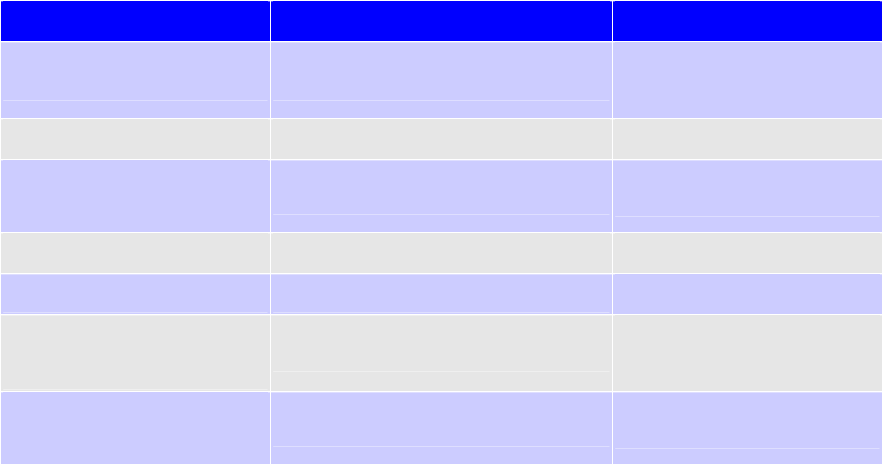
41
6.1.5 Log
6.1.6 System Time
Parameter Description Default Value
Setting by Synchronize with an
Internet Time Server
Year / Month / Day
07/8/20
Hour : Minute :
Second 02:26:06
Hours from UTC +8
Server IP pool.ntp.org
NTP Server for
Reference pool.ntp.org or
129.132.2.21
Time Update for
Every 0/0/0
6.1.7 Reboot
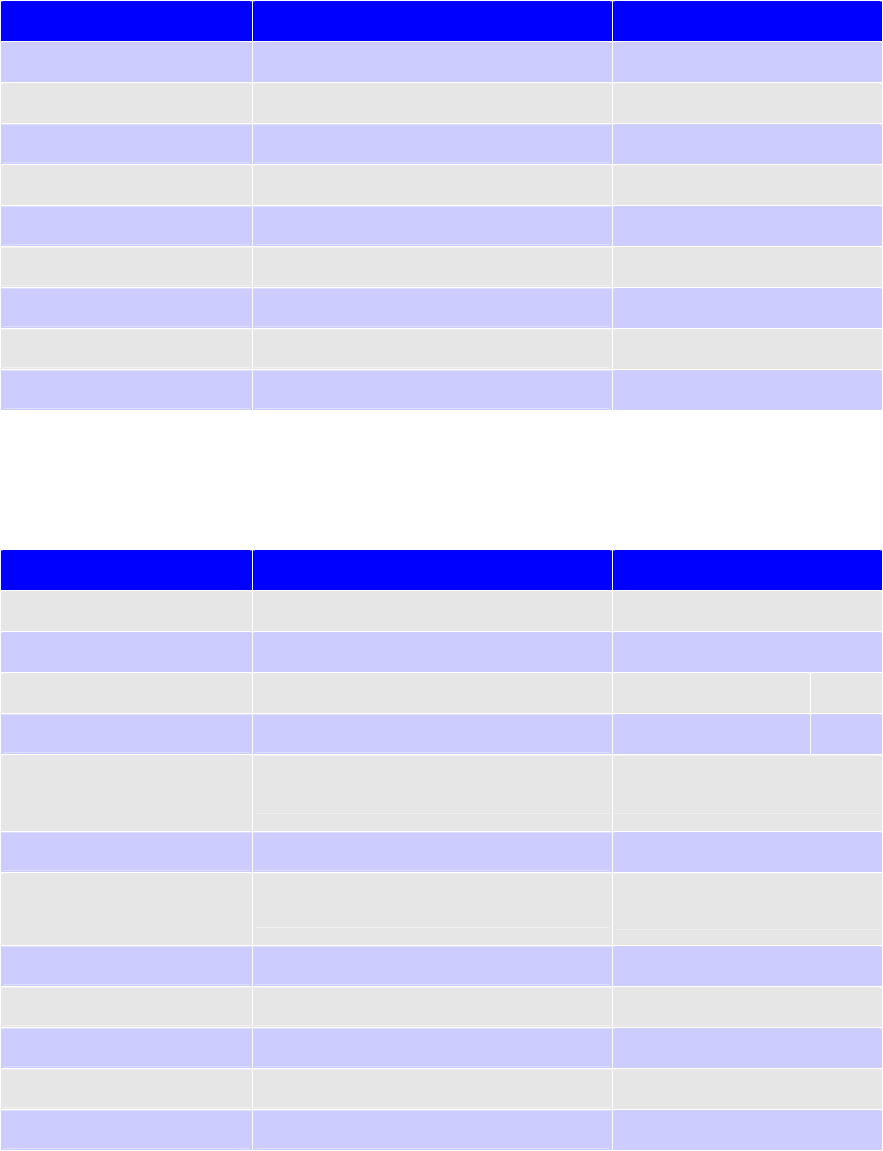
42
6.2 NETWORK
6.2.1 Network
Parameter Description Default Value
Operating Access Point
IP Assignment Manual
IP Address 192.168.1.1
Subnet Mask 255.255.255.0
Gateway 0.0.0.0
DNS Server 0.0.0.0
Link Integrity Disable
PPPoE Username
PPPoE Password
6.2.2 Hotspot
Parameter Description Default Value
HotSpot Status Disable
Domain
Primary Radius 0.0.0.0 1812
Secondary Radius
0.0.0.0 1813
Radius Shared
Secret
NAS ID EKI-6311G
Called Station
Name EKI-6311G
NAS Location
NAS Location ID
UAM URL
UAM Secret
UAM Allowed List
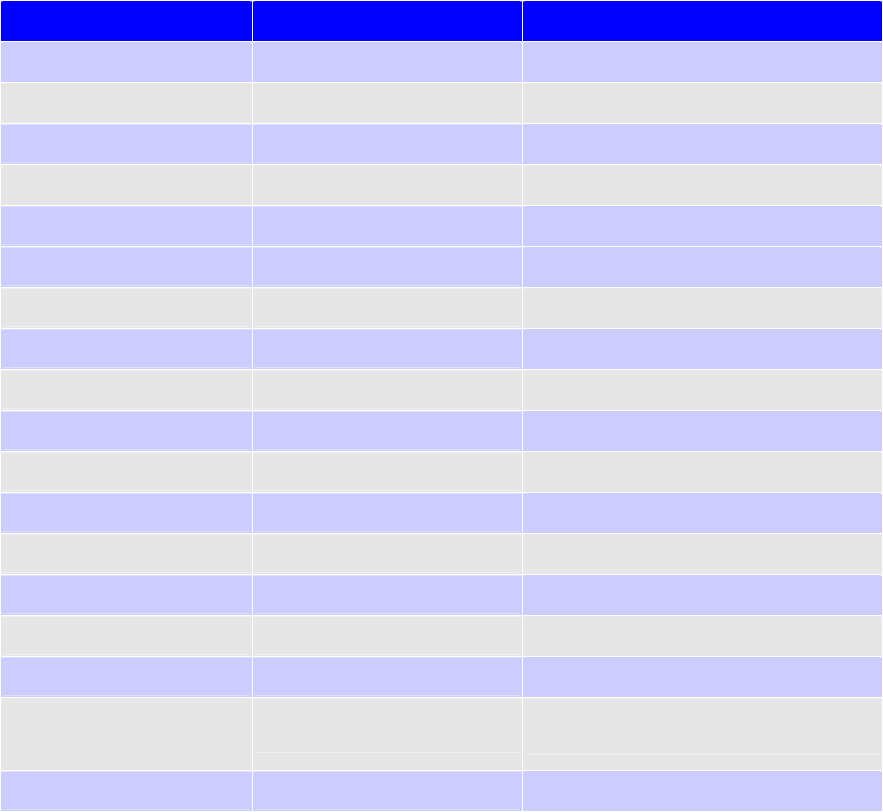
43
6.3 WIRELESS
6.3.1 Wi-Fi 1
Parameter Description Default Value
Country TAIWAN
Radio Status Enable
Wireless Role Access Point
Radio Mode 802.11b+g
Radio Channel Channel 1, 2412MHz
Antenna mode Internal
Peer Node Distance
100 meters
SSID Advantech/1
Transmission Power
17dBm
Frag. Threshold 2346
RTS Threshold 2346
Beacon Interval 100
DTIM Interval 1
Wireless Security None
VLAN Tagging ID 1
Layer2 Isolation Disable
Maximum Associated
Stations 32
WMM Status Disable
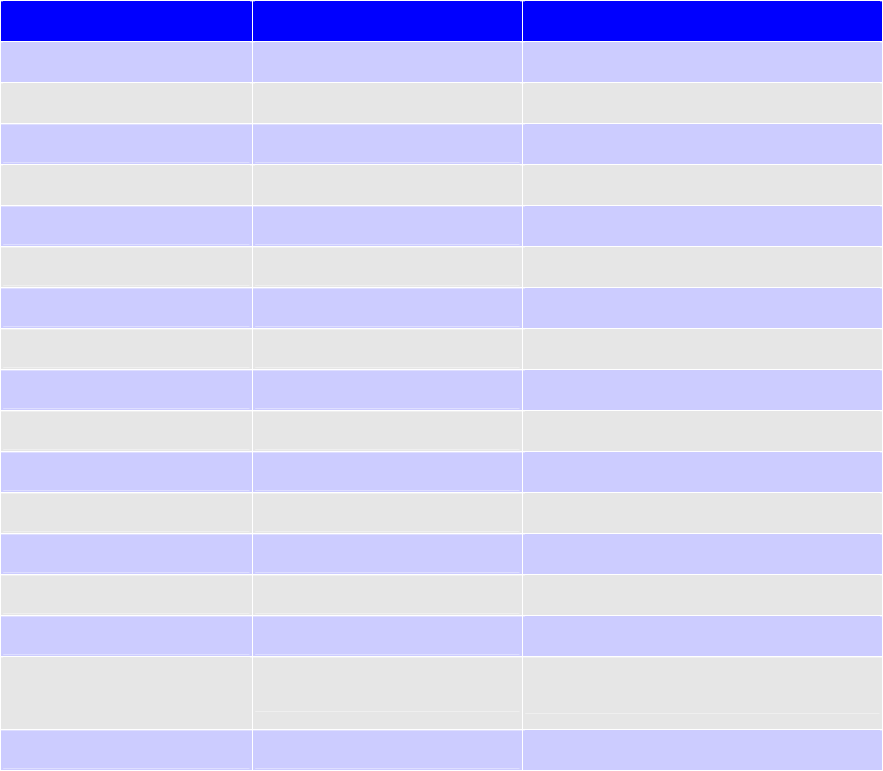
44
6.3.2 Wi-Fi 2
Parameter Description Default Value
Country TAIWAN
Radio Status Disable
Wireless Role Access Point
Radio Mode 802.11b+g
Radio Channel Channel 1, 2412MHz
Peer Node Distance
100 meters
SSID Advantech/2
Transmission Power
17dBm
Frag. Threshold 2346
RTS Threshold 2346
Beacon Interval 100
DTIM Interval 1
Wireless Security None
VLAN Tagging ID 2
Layer2 Isolation Disable
Maximum Associated
Stations 32
WMM Status Disable
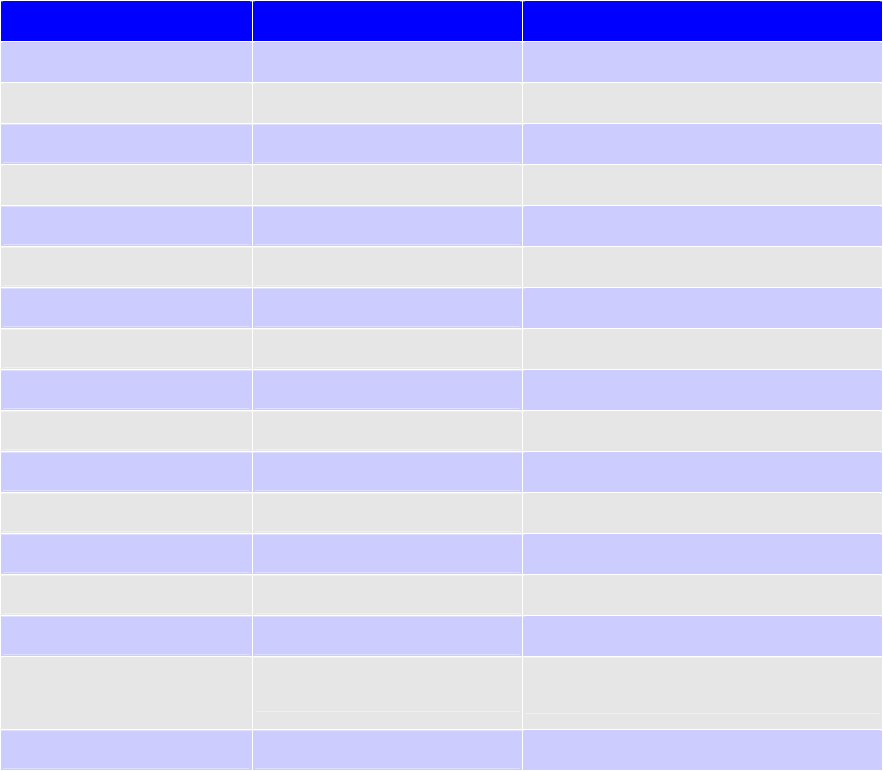
45
6.3.3 Wi-Fi 3
Parameter Description Default Value
Country TAIWAN
Radio Status Disable
Wireless Role Access Point
Radio Mode 802.11b+g
Radio Channel Channel 1, 2412MHz
Peer Node Distance
100 meters
SSID Advantech/3
Transmission Power
17dBm
Frag. Threshold 2346
RTS Threshold 2346
Beacon Interval 100
DTIM Interval 1
Wireless Security None
VLAN Tagging ID 2
Layer2 Isolation Disable
Maximum Associated
Stations 32
WMM Status Disable
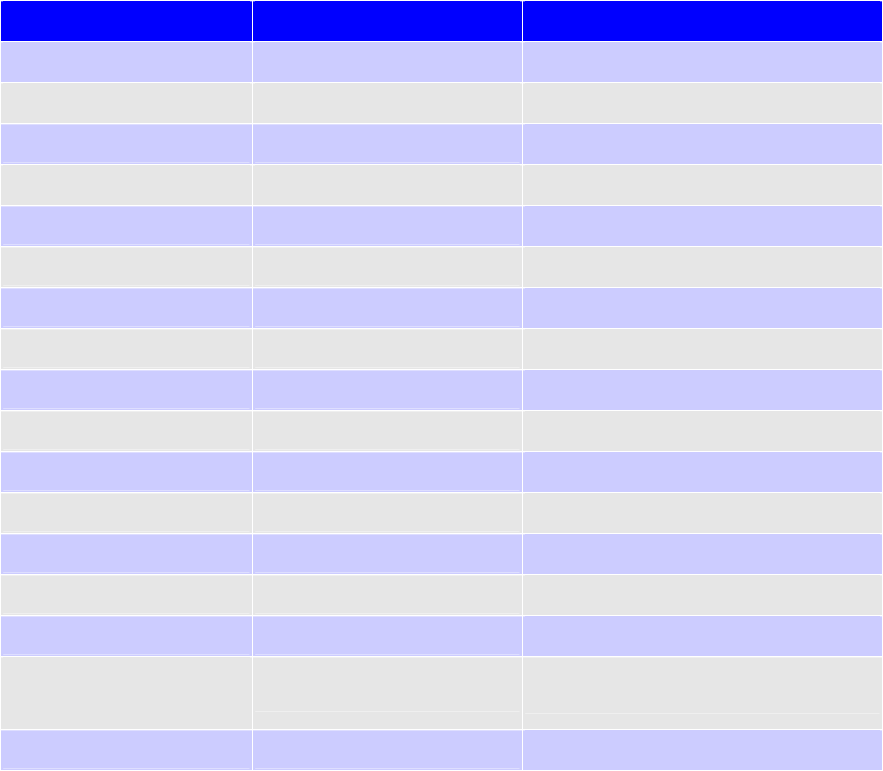
46
6.3.4 Wi-Fi 4
Parameter Description Default Value
Country TAIWAN
Radio Status Disable
Wireless Role Access Point
Radio Mode 802.11b+g
Radio Channel Channel 1, 2412MHz
Peer Node Distance
100 meters
SSID Advantech/4
Transmission Power
17dBm
Frag. Threshold 2346
RTS Threshold 2346
Beacon Interval 100
DTIM Interval 1
Wireless Security None
VLAN Tagging ID 2
Layer2 Isolation Disable
Maximum Associated
Stations 32
WMM Status Disable
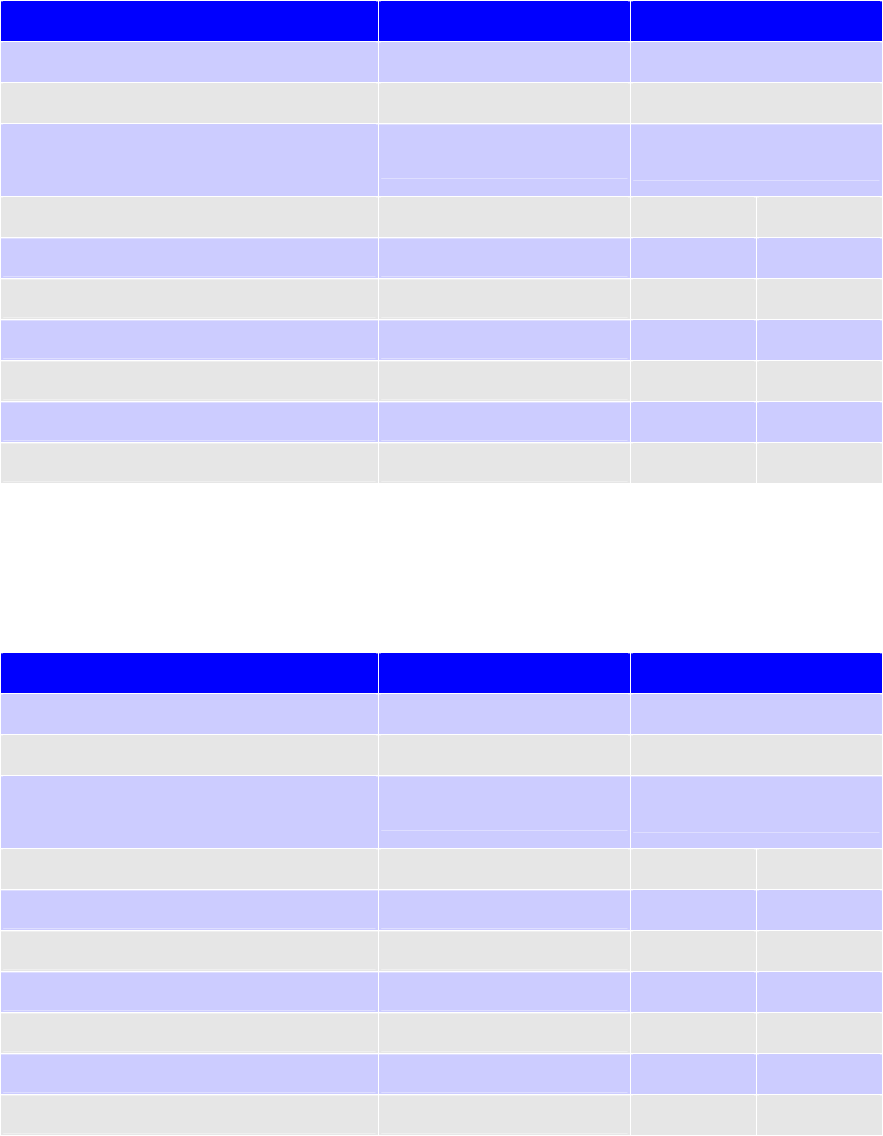
47
6.4 ACL
6.4.1 ACL for Wi-Fi
Parameter Description Default Value
Wireless MAC ACL Status Disable
Add New MAC Address 00:00:00:00:00:00
Wireless On/Off Schedulin
g
Status Disabled
Scheduling on Sunday 0 24
Scheduling on Monday 0 24
Scheduling on Tuesday 0 24
Scheduling on Wednesday 0 24
Scheduling on Thursday 0 24
Scheduling on Friday 0 24
Scheduling on Saturday 0 24
6.4.2 ACL for Wi-Fi 2
Parameter Description Default Value
Wireless MAC ACL Status Disable
Add New MAC Address 00:00:00:00:00:00
Wireless On/Off Schedulin
g
Status Disabled
Scheduling on Sunday 0 24
Scheduling on Monday 0 24
Scheduling on Tuesday 0 24
Scheduling on Wednesday 0 24
Scheduling on Thursday 0 24
Scheduling on Friday 0 24
Scheduling on Saturday 0 24
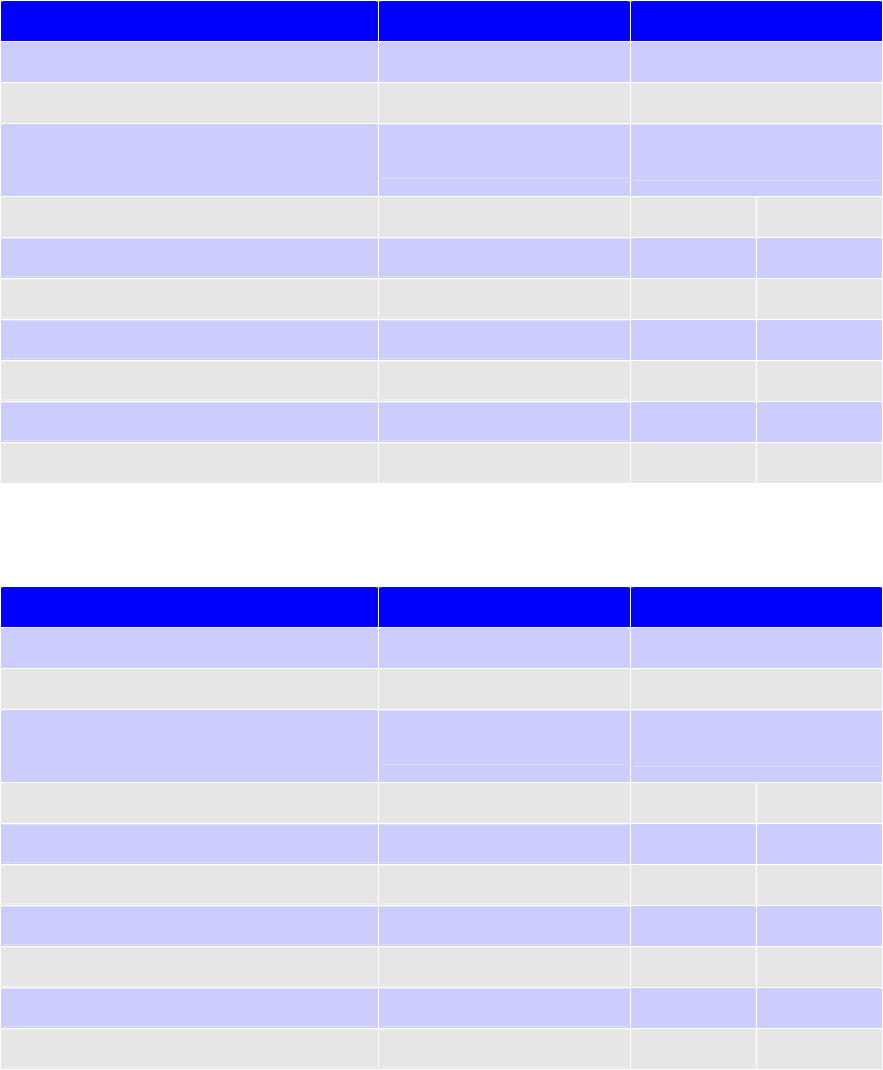
48
6.4.3 ACL for Wi-Fi 3
Parameter Description Default Value
Wireless MAC ACL Status Disable
Add New MAC Address 00:00:00:00:00:00
Wireless On/Off Schedulin
g
Status Disabled
Scheduling on Sunday 0 24
Scheduling on Monday 0 24
Scheduling on Tuesday 0 24
Scheduling on Wednesday 0 24
Scheduling on Thursday 0 24
Scheduling on Friday 0 24
Scheduling on Saturday 0 24
6.4.4 ACL for Wi-Fi 4
Parameter Description Default Value
Wireless MAC ACL Status Disable
Add New MAC Address 00:00:00:00:00:00
Wireless On/Off Schedulin
g
Status Disabled
Scheduling on Sunday 0 24
Scheduling on Monday 0 24
Scheduling on Tuesday 0 24
Scheduling on Wednesday 0 24
Scheduling on Thursday 0 24
Scheduling on Friday 0 24
Scheduling on Saturday 0 24
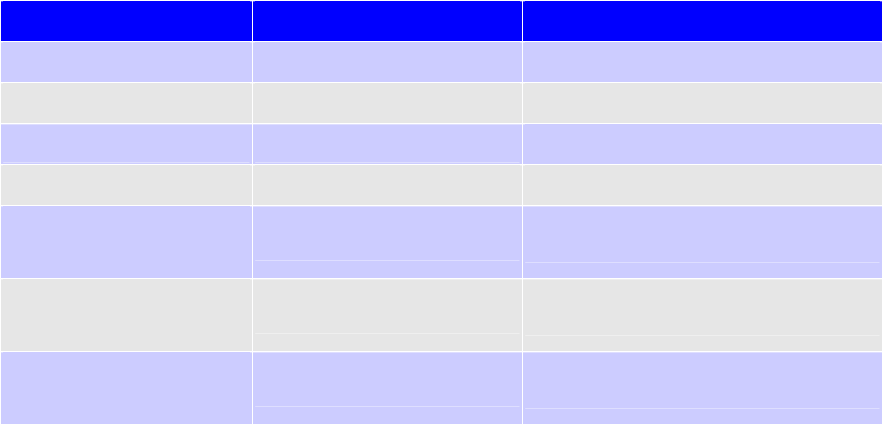
49
6.5 SNMP
Parameter Description Default Value
Agent Status Enable
System Location
System Contact
System Name Advantech
System
Description Advantech Wireless AP/CB
Read Only
Community public
Read Write
Community Private
6.6 EXIT
50
Chapter 7. Regulatory Compliance Information
Federal Communication Commission Interference Statement
This equipment has been tested and found to comply with the limits for a Class B
digital device, pursuant to Part 15 of the FCC Rules. These limits are designed to
provide reasonable protection against harmful interference in a residential
installation. This equipment generates, uses and can radiate radio frequency
energy and, if not installed and used in accordance with the instructions, may cause
harmful interference to radio communications. However, there is no guarantee that
interference will not occur in a particular installation. If this equipment does cause
harmful interference to radio or television reception, which can be determined by
turning the equipment off and on, the user is encouraged to try to correct the
interference by one of the following measures:
- Reorient or relocate the receiving antenna.
- Increase the separation between the equipment and receiver.
- Connect the equipment into an outlet on a circuit different from that
to which the receiver is connected.
- Consult the dealer or an experienced radio/TV technician for help.
This device complies with Part 15 of the FCC Rules. Operation is subject to the
following two conditions: (1) This device may not cause harmful interference, and (2)
this device must accept any interference received, including interference that may
cause undesired operation.
FCC Caution: Any changes or modifications not expressly approved by the party
responsible for compliance could void the user's authority to operate this equipment.
IMPORTANT NOTE:
FCC Radiation Exposure Statement:
This equipment complies with FCC radiation exposure limits set forth for an
uncontrolled environment. This equipment should be installed and operated with
minimum distance 20cm between the radiator & your body.
This transmitter must not be co-located or operating in conjunction with any other antenna

Antenna type Antenna Gain
Patch 9dBi
Omni 5dBi
51